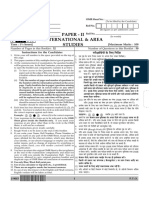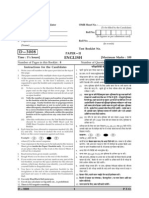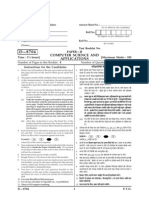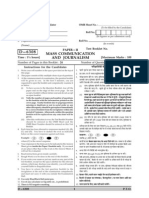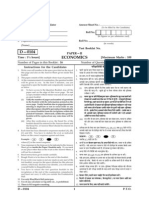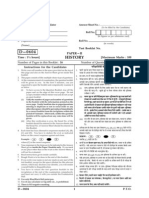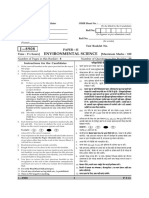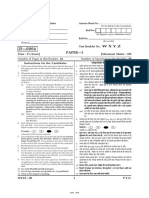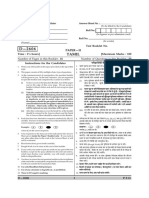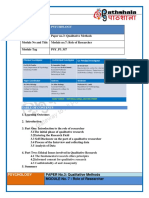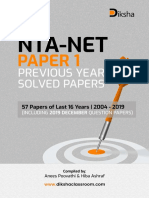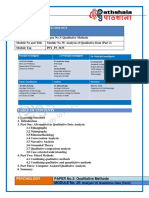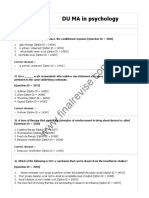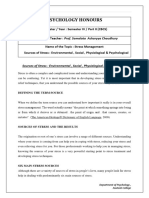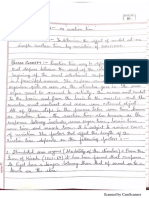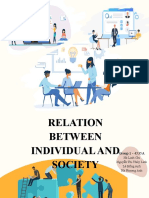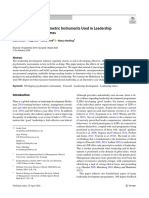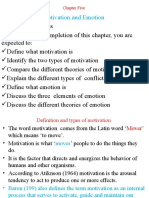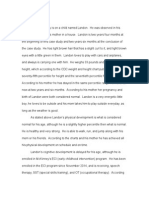D 0415 Paper II Psychology
D 0415 Paper II Psychology
Uploaded by
einsteinCopyright:
Available Formats
D 0415 Paper II Psychology
D 0415 Paper II Psychology
Uploaded by
einsteinCopyright
Available Formats
Share this document
Did you find this document useful?
Is this content inappropriate?
Copyright:
Available Formats
D 0415 Paper II Psychology
D 0415 Paper II Psychology
Uploaded by
einsteinCopyright:
Available Formats
Signature and Name of Invigilator OMR Sheet No. : ..........................................................
(To be filled by the Candidate)
1. (Signature)
Roll No.
(Name)
(In figures as per admission card)
2. (Signature)
Roll No.
(Name) (In words)
D0 4 1 5 PAPER - II
Time : 1¼ hours] PSYCHOLOGY [Maximum Marks : 100
Number of Pages in this Booklet : 32 Number of Questions in this Booklet : 50
Instructions for the Candidates ÂÚUèÿææçÍüØô¢ ·ð¤ çÜ° çÙÎðüàæ
1. Write your roll number in the space provided on the top of
1. §â ÂëDU ·ð¤ ª¤ÂÚU çÙØÌ SÍæÙ ÂÚU ¥ÂÙæ ÚUôÜU ÙÕÚU çÜç¹°Ð
this page.
2. This paper consists of fifty multiple-choice type of questions. 2. §â ÂýàÙ-Âæ ×𢠿æâ Õãéçß·¤ËÂèØ ÂýàÙ ãñ´Ð
3. At the commencement of examination, the question booklet 3. ÂÚUèÿææ ÂýæÚUÖ ãôÙð ÂÚU, ÂýàÙ-ÂéçSÌ·¤æ ¥æ·¤ô Îð Îè ÁæØð»èÐ ÂãÜðU ÂUæ¡¿ ç×ÙÅU
will be given to you. In the first 5 minutes, you are requested ¥æ·¤ô ÂýàÙ-ÂéçSÌ·¤æ ¹ôÜÙð ÌÍæ ©â·¤è çÙÙçÜç¹Ì Áæ¡¿ ·ð¤ çÜ° çÎØð
to open the booklet and compulsorily examine it as below : ÁæØð¢»ð, çÁâ·¤è Áæ¡¿ ¥æ·¤ô ¥ßàØ ·¤ÚUÙè ãñ Ñ
(i) To have access to the Question Booklet, tear off the (i) ÂýàÙ-ÂéçSÌ·¤æ ¹ôÜÙð ·ð¤ çÜ° ÂéçSÌ·¤æ ÂÚU Ü»è ·¤æ»Á ·¤è âèÜ ·¤æð
paper seal on the edge of this cover page. Do not accept
ȤæǸ Üð¢UÐ ¹éÜè ãé§ü Øæ çÕÙæ SÅUè·¤ÚU-âèÜU ·¤è ÂéçSÌ·¤æ Sßè·¤æÚU Ù ·¤Úð¢UÐ
a booklet without sticker-seal and do not accept an open
booklet. (ii) ·¤ßÚU ÂëDU ÂÚU ÀUÂð çÙÎðüàææÙéâæÚU ÂýàÙ-ÂéçSÌ·¤æ ·ð¤ ÂëDU ÌÍæ ÂýàÙô¢ ·¤è
(ii) Tally the number of pages and number of questions in â¢Øæ ·¤ô ¥ÀUè ÌÚUã ¿ñ·¤ ·¤ÚU Üð¢U ç·¤ Øð ÂêÚðU ãñ¢UÐ ÎôáÂêæü ÂéçSÌ·¤æ
the booklet with the information printed on the cover çÁÙ×ð¢ ÂëDU/ÂýàÙ ·¤× ãô¢ Øæ ÎéÕæÚUæ ¥æ »Øð ãô¢ Øæ âèçÚUØÜU ×ð¢ Ù ãô¢
page. Faulty booklets due to pages/questions missing ¥ÍæüÌ ç·¤âè Öè Âý·¤æÚU ·¤è æéçÅUÂêæü ÂéçSÌ·¤æ Sßè·¤æÚU Ù ·¤Úð¢U ÌÍæ
or duplicate or not in serial order or any other ©âè â×Ø ©âð ÜUõÅUæ·¤ÚU ©â·ð¤ SÍæÙ ÂÚU ÎêâÚUè âãè ÂýàÙ-ÂéçSÌ·¤æ Üð
discrepancy should be got replaced immediately by a
Üð¢Ð U §â·ð¤ çÜ° ¥æ·¤ô Âæ¡¿ ç×ÙÅU çÎØð ÁæØð¢»ðÐ ©â·ð¤ ÕæÎ Ù Ìô
correct booklet from the invigilator within the period
of 5 minutes. Afterwards, neither the Question Booklet ¥æ·¤è ÂýàÙ-ÂéçSÌ·¤æ ßæÂâ Üè ÁæØð»è ¥õÚU Ù ãè ¥æ·¤ô ¥çÌçÚUQ¤
will be replaced nor any extra time will be given. â×Ø çÎØæ ÁæØð»æÐ
(iii) After this verification is over, the Test Booklet Number (iii) §â Áæ¡¿ ·ð¤ ÕæÎ ÂýàÙ-ÂéçSÌ·¤æ ·¤æ Ù´ÕÚU OMR Âæ·¤ ÂÚU ¥¢ç·¤Ì ·¤Úð¢U
should be entered on the OMR Sheet and the OMR Sheet ¥UõÚU OMR Âæ·¤ ·¤æ Ù´ÕÚU §â ÂýàÙ-ÂéçSÌ·¤æ ÂÚU ¥¢ç·¤Ì ·¤ÚU Îð¢Ð
Number should be entered on this Test Booklet. 4. ÂýØð·¤ ÂýàÙ ·ð¤ çÜ° ¿æÚU ©æÚU çß·¤Ë (1), (2), (3) ÌÍæ (4) çÎØð »Øð ãñ¢Ð
4. Each item has four alternative responses marked (1), (2), (3)
and (4). You have to darken the circle as indicated below on
¥æ·¤ô âãè ©æÚU ·ð¤ ßëæ ·¤ô ÂðÙ âð ÖÚU·¤ÚU ·¤æÜæ ·¤ÚUÙæ ãñ Áñâæ ç·¤ Ùè¿ð
the correct response against each item. çιæØæ »Øæ ãñÐ
Example : where (3) is the correct response. ©ÎæãÚUæ Ñ ÁÕç·¤ (3) âãè ©æÚU ãñÐ
5. Your responses to the items are to be indicated in the OMR 5. ÂýàÙæ𴠷𤠩æÚU ·ð¤ßÜ ÂýàÙ ÂéçSÌ·¤æ ·ð¤ ¥ÎÚU çÎØð »Øð OMRU Âæ·¤ ÂÚU ãè
Sheet given inside the Booklet only. If you mark your ¥´ç·¤Ì ·¤ÚUÙð ãñ´Ð ØçÎ ¥æ OMRU Âæ·¤ ÂÚU çÎØð »Øð ßëæ ·ð¤ ¥Üæßæ ç·¤âè
response at any place other than in the circle in the OMR ¥Ø SÍæÙ ÂÚU ©æÚU ç¿ãæ¢ç·¤Ì ·¤ÚUÌð ãñ´, Ìô ©â·¤æ ×êËUØ梷¤Ù Ùãè¢ ãô»æÐ
Sheet, it will not be evaluated. 6. ¥ÎÚU çÎØð »Øð çÙÎðüàæô¢ ·¤ô ØæÙÂêßü·¤ Âɸð¢UÐ
6. Read instructions given inside carefully.
7. ·¤ææ ·¤æ× (Rough Work) §â ÂéçSÌ·¤æ ·ð¤ ¥çÌ× ÂëDU ÂÚU ·¤Úð¢UÐ
7. Rough Work is to be done in the end of this booklet.
8. If you write your Name, Roll Number, Phone Number or 8. ØçÎ ¥æ OMR Âæ·¤ ÂÚU çÙØÌ SÍæÙ ·ð¤ ¥Üæßæ ¥ÂÙæ Ùæ×, ÚUæðÜ ÙÕÚU,
put any mark on any part of the OMR Sheet, except for the ȤæðÙ ÙÕÚU Øæ ·¤æð§ü Öè °ðâæ ç¿q çÁââð ¥æ·¤è Âã¿æÙ ãæð â·ð¤, ¥´ç·¤Ì ·¤ÚUÌð
space allotted for the relevant entries, which may disclose ãñ´ ¥Íßæ ¥ÖÎý Öæáæ ·¤æ ÂýØæð» ·¤ÚUÌð ãñ´, Øæ ·¤æð§ü ¥Ø ¥Ùéç¿Ì âæÏÙ ·¤æ
your identity, or use abusive language or employ any other ÂýØæð» ·¤ÚUÌð ãñ´, Áñâð ç·¤ ¥´ç·¤Ì ç·¤Øð »Øð ©æÚU ·¤æð ç×ÅUæÙæ Øæ âÈð¤Î SØæãè âð
unfair means, such as change of response by scratching or ÕÎÜÙæ Ìæð ÂÚUèÿææ ·ð¤ çÜØð ¥ØæðØ ææðçáÌ ç·¤Øð Áæ â·¤Ìð ãñ´Ð
using white fluid, you will render yourself liable to
9. ¥æ·¤ô ÂÚUèÿææ â×æ# ãôÙð ¤ÂÚU ×êÜ OMR Âæ·¤ çÙÚUèÿæ·¤ ×ãôÎØ ·¤ô ÜUõÅUæÙæ
disqualification.
9. You have to return the original OMR Sheet to the invigilators
¥æßàØ·¤ ãñ ¥õÚU ÂÚUèÿææ â×æç# ·ð¤ ÕæÎ ©âð ¥ÂÙð âæÍ ÂÚUèÿææ ÖßÙ âð ÕæãÚU
at the end of the examination compulsorily and must not Ù Üð·¤ÚU ÁæØð¢Ð ãæÜæ´ç·¤ ¥æ ÂÚUèÿææ â×æç# ÂÚU ×êÜ ÂýàÙ-ÂéçSÌ·¤æ ÌÍæ OMR
carry it with you outside the Examination Hall. You are Âæ·¤ ·¤è ÇéUÜè·ð¤ÅU ÂýçÌ ¥ÂÙð âæÍ Üð Áæ â·¤Ìð ãñ´Ð
however, allowed to carry original question booklet and 10. ·ð¤ßÜ ÙèÜð/·¤æÜð ÕæÜU ßæ§ZÅU ÂðÙ ·¤æ ãè §SÌð×æÜ ·¤Úð¢UÐ
duplicate copy of OMR Sheet on conclusion of examination. 11. ç·¤âè Öè Âý·¤æÚU ·¤æ ⢻淤 (·ñ¤Ü·é¤ÜðÅUÚU) UØæ Üæ» ÅðUÕÜ ¥æçÎ ·¤æ
10. Use only Blue/Black Ball point pen.
ÂýØô» ßçÁüÌ ãñÐ
11. Use of any calculator or log table etc., is prohibited.
12. There are no negative marks for incorrect answers. 12. »ÜÌ ©æÚUæð´ ·ð¤ çÜ° ·¤æð§ü Ù·¤æÚUæ×·¤ ¥´·¤ Ùãè´ ãñ´Ð
13. In case of any discrepancy in the English and Hindi versions, 13. ØçÎ ¥´»ýðÁè Øæ çã´Îè çßßÚUæ ×ð´ ·¤æð§ü çßâ´»çÌ ãæð, Ìæð ¥´»ýðÁè çßßÚUæ ¥´çÌ×
English version will be taken as final. ×æÙæ Áæ°»æÐ
D-0415 !D-0415-PAPER-II! 1 P.T.O.
PSYCHOLOGY
PAPER - II
Note : This paper contains fifty (50) objective type questions of two (2) marks each. All questions
are compulsory.
1. Motion sickness can occur when :
(a) one loses his vestibular sense.
(b) one relies only on visual information.
(c) ones visual information and vestibular systems information are congruent.
(d) ones visual system and vestibular system are in conflict.
Codes :
(1) (a) only (2) (a) and (b)
(3) (d) only (4) (a) and (d)
2. Read each of the following two statements - Assertion (A) and Reason (R) and indicate
your answer using the codes given below :
Assertion (A) : Iconic store is a discrete visual sensory store.
Reason (R) : Because information is believed to be stored in the form of visual codes.
Codes :
(1) Both (A) and (R) are true and (R) is the correct explanation of (A).
(2) Both (A) and (R) are true, but (R) is not the correct explanation of (A).
(3) (A) is true, but (R) is false.
(4) (A) is false, but (R) is true.
3. Backward Conditioning occurs when :
(1) CS and US are presented simultaneously
(2) CS is presented first and US is presented before the termination of CS
(3) CS is presented first and US is presented after the termination of CS
(4) US is presented first and CS is presented after the termination of US
D-0415 !D-0415-PAPER-II! 2 Paper-II
×ÙæðçßææÙ
ÂýàÙ-Âæ - II
çÙÎðüàæ Ñ §â ÂýàÙ-Âæ ×ð´ ¿æâ (50) Õãé-çß·¤ËÂUèØ ÂýàÙ ãñ´Ð ÂýØð·¤ ÂýàÙ ·ð¤ Îô (2) ¥¢·¤ ãñ´Ð âÖè ÂýàÙ ¥çÙßæØü ãñ´Ð
1. »çÌ âÕ´Ïè ÚUæð» ©â çSÍçÌ ×ð´ ãæðÌæ ãñ Ñ
(a) ÁÕ ç·¤âè ·¤è Âýæææ â´ßðÎÙæ â×æ# ãæð ÁæÌè ãñÐ
(b) ÁÕ ·¤æð§ü ÃØçÌ ·ð¤ßÜ ÎëàØ âê¿Ùæ¥æð´ ÂÚU çÙÖüÚU ÚUãÌæ ãñÐ
(c) ÁÕ ç·¤âè Öè ÎëàØ âê¿Ùæ¥æð´ ¥æñÚU Âýæææ Ì´æ ·¤è âê¿Ùæ ×ð´ ÌæÜ×ðÜ ãæðÌæ ãñÐ
(d) ÁÕ ç·¤âè ·ð¤ ÎëàØ Ìæ ¥æñÚU Âýæææ Ì´æ ×ð´ ÂÚUSÂÚU ¥Ìmüm ãæðÌæ ãñÐ
·ê¤ÅU Ñ
(1) ·ð¤ßÜ (a) (2) (a) ¥æñÚU (b)
(3) ·ð¤ßÜ (d) (4) (a) ¥æñÚU (d)
2. çÙÙçÜç¹Ì Îæð ·¤ÍÙæð´ - ¥çÖ·¤ÍÙ (A) ¥æñÚU Ì·ü¤ (R) ·¤æð Âçɸ° ¥æñÚU Ùè¿ð çΰ »° ·ê¤ÅUæð´ ·¤æ ©ÂØæð» ·¤ÚUÌð ãé°
¥ÂÙæ ©æÚU ÎèçÁ° Ñ
¥çÖ·¤ÍÙ (A) : ÂýçÌ×æÂÚU·¤ ÖÇUæÚU, çßçÀUóæ ÎëçcÅU â´ßðÎè ÖÇUæÚU ãñÐ
Ì·ü¤ (R) : Øæð´ç·¤ °ðâæ ×æÙæ ÁæÌæ ãñ ç·¤ âê¿Ùæ ÎëçcÅU ·ê¤ÅUæð´ ·ð¤ M¤Â ×ð´ ÖÇUæçÚUÌ ãæðÌè ãñÐ
·ê¤ÅU Ñ
(1) (A) ¥æñÚU (R) ÎæðÙæð´ âãè ãñ´ ¥æñÚU (R), (A) ·¤è âãè ÃØæØæ ãñÐ
(2) (A) ¥æñÚU (R) ÎæðÙæð´ âãè ãñ´, Üðç·¤Ù (R), (A) ·¤è âãè ÃØæØæ Ùãè´ ãñÐ
(3) (A) âãè ãñ, Üðç·¤Ù (R) »ÜÌ ãñÐ
(4) (A) »ÜÌ ãñ, Üðç·¤Ù (R) âãè ãñÐ
3. ÁÕ Âà¿»æ×è ¥ÙéÕ´ÏÙ ãæðÌæ ãñ Ñ
(1) ¥Ùé·ê¤çÜÌ ©gè·¤ ¥æñÚU ¥ÙæÙé·ê¤çÜÌ ©gè·¤ âæÍ-âæÍ ÂýSÌéÌ ãæðÌð ãñ´Ð
(2) ¥Ùé·ê¤çÜÌ ©gè·¤ ÂãÜð ×æñÁêÎ ãæðÌæ ãñ ¥æñÚU ¥ÙæÙé·ê¤çÜÌ ©gè·¤ ¥Ùé·ê¤çÜÌ ©gè·¤ ·ð¤ ÂçÚUâ×æÂÙ ·ð¤ Âêßü
ÂýSÌéÌ ãæðÌæ ãñÐ
(3) ¥Ùé·ê¤çÜÌ ©gè·¤ ÂãÜð ×æñÁêÎ ãæðÌæ ãñ ¥æñÚU ¥ÙæÙé·ê¤çÜÌ ©gè·¤ ¥Ùé·ê¤çÜÌ ©gè·¤ ·ð¤ ÂçÚUâ×æÂÙ ·ð¤
Âà¿æÌ÷ ÂýSÌéÌ ãæðÌæ ãñÐ
(4) ¥ÙæÙé·ê¤çÜÌ ©gè·¤ ÂãÜð ÂýSÌéÌ ãæðÌæ ãñ ¥æñÚU ¥ÙæÙé·ê¤çÜÌ ©gè·¤ ·ð¤ ÂçÚUâ×æÂÙ ·ð¤ Âà¿æÌ÷ ¥Ùé·ê¤çÜÌ
©gè·¤ ×æñÁêÎ ãæðÌæ ãñÐ
D-0415 !D-0415-PAPER-II! 3 Paper-II
4. Which among the following defines problem space ?
(a) An initial state
(b) A goal state
(c) A set of operations
Codes :
(1) (a) and (c) (2) (a) and (b) (3) (b) and (c) (4) (a), (b) and (c)
5. The James-Lange theory and the cognitive theory of emotion disagree on whether :
(1) specific brain centers are involved in specific emotions.
(2) bodily feedback determines which emotion is felt.
(3) individuals can judge their emotions accurately.
(4) there is no any biological involvement in human emotions.
6. Match List-I with List-II and select the correct answer by choosing from the codes given
below :
List-I List-II
(a) Binet (i) Intelligent people often have intelligent relatives
(b) Broca (ii) Performance based intelligence tests eliminate cultural bias
(c) Wechsler (iii) Correlation between intelligence and brain size
(d) Galton (iv) Intelligence is a collection of mental abilities
Codes :
(a) (b) (c) (d)
(1) (i) (ii) (iii) (iv)
(2) (ii) (iii) (iv) (i)
(3) (iii) (iv) (i) (ii)
(4) (iv) (iii) (ii) (i)
7. Biologically based emotional and behavioural tendencies that are evident in early childhood
represent :
(1) Trait (2) Type (3) Temperament (4) Style
D-0415 !D-0415-PAPER-II! 4 Paper-II
4. çÙÙçÜç¹Ì ×ð´ âð ·¤æñÙ â×SØæ ÿæðæ ·¤æð ÂçÚUÖæçáÌ ·¤ÚUÌð ãñ´?
(a) °·¤ ÂýæÍç×·¤ ¥ßSÍæ
(b) °·¤ ÜÿØ ¥ßSÍæ
(c) ¥çÖØæÙæð´ ·¤æ °·¤ â×êã
·ê¤ÅU Ñ
(1) (a) ¥æñÚU (c) (2) (a) ¥æñÚU (b) (3) (b) ¥æñÚU (c) (4) (a), (b) ¥æñÚU (c)
5. â´ßð» ·ð¤ Áðâ-Üñ´»ð ß â´ææÙæ×·¤ çâhæ´Ì çÙÙ ×ð´ âð ç·¤â ÂÚU âã×Ì Ùãè´ ã´ñ?
(1) çßçàæcÅU ×çSÌc·¤ ·ð´¤Îý çßçàæcÅU â´ßð»æð´ ×ð´ â´ÜÙ ãæðÌð ãñ´Ð
(2) àææÚUèçÚU·¤ çÙçßçcÅU (ȤèÇUÕñ·¤) ÌØ ·¤ÚUÌè ãñ ç·¤ ç·¤â â´ßð» ·¤æ ¥ÙéÖß ãæðÌæ ãñÐ
(3) ÃØçÌ ¥ÂÙð â´ßð»æð´ ·ð¤ â´Õ´Ï ×ð´ âãè É´U» âð çÙæüØ Üð â·¤Ìð ãñ´Ð
(4) ×æÙßèØ â´ßð»æð´ ×ð´ ·¤æð§ü Áñçß·¤ â´çÜ#Ìæ Ùãè´ ãæðÌè ãñÐ
6. âê¿è-I ¥æñÚU âê¿è-II ·¤æð âé×ðçÜÌ ·¤èçÁ° ¥æñÚU Ùè¿ð çΰ »° ·ê¤ÅUæð´ ×ð´ âð âãè ©æÚU ¿éçÙ° Ñ
âê¿è-I âê¿è-II
(a) çÕÙðÅU (i) Õéçh×æÙ Üæð»æð´ ·ð¤ çÚUàÌðÎæÚU ÂýæØÑ Õéçh×æÙ ãæðÌð ãñ´
(b) Õýæð·¤æ (ii) çÙcÂæÎÙ ¥æÏæçÚUÌ Õéçh ÂÚUèÿææ âæ´S·ë¤çÌ·¤ ÕæØâ ·¤æð â×æ# ·¤ÚUÌè ãñ
(c) ßðSÜÚU (iii) Õéçh ¥æñÚU ×çSÌc·¤ ·ð¤ ¥æ·¤æÚU ·ð¤ Õè¿ âã-â´Õ´Ï
(d) »æËÅUÙ (iv) Õéçh-×æÙçâ·¤ ÿæ×Ìæ¥æð´ ·¤æ â´»ýã ãñ
·ê¤ÅU Ñ
(a) (b) (c) (d)
(1) (i) (ii) (iii) (iv)
(2) (ii) (iii) (iv) (i)
(3) (iii) (iv) (i) (ii)
(4) (iv) (iii) (ii) (i)
7. Õ¿ÂÙ ×ð´ Âæ§ü ÁæÙð ßæÜè Áèß çßææÙ ¥æÏæçÚUÌ ÖæßÙæ×·¤ ¥æñÚU ÃØßãæÚU â´Õ´Ïè ÂýßëçæØæ¡ çÙÙçÜç¹Ì ·¤æ ÂýçÌçÙçÏß
·¤ÚUÌè ãñ´ Ñ
(1) àæèÜ-»éæ (2) Âý·¤æÚU (3) SßÖæß/Âý·ë¤çÌ (4) àæñÜè
D-0415 !D-0415-PAPER-II! 5 Paper-II
8. In Jungian theory, the idea that energy is automatically redistributed in the psyche in order
to achieve equilibrium or balance depicts :
(1) Principle of Equivalence (2) Principle of Synchronicity
(3) Principle of Entrophy (4) Principle of Opposites
9. After the recent terrorist attacks in France, a psychologist proposed a study wherein he
would interview two hundred French citizens to find whether their attitude towards fate as
a consequence of the attack. This study can best be labelled as :
(1) attitude change experiment (2) field experiment
(3) ex post facto study (4) psychometric study
10. Match List-I with List-II and select the correct answer by choosing from the codes given
below :
List-I List-II
(Cutaneous receptors) (Responds to)
(a) Free nerve endings (i) Sudden displacement of skin
(b) Ruffini endings (ii) Gradual skin indentation
(c) Merkels disks (iii) Gradual skin stretch
(d) Pacinian corpuscles (iv) Temperature change and pain
Codes :
(a) (b) (c) (d)
(1) (i) (ii) (iii) (iv)
(2) (ii) (iii) (iv) (i)
(3) (iii) (iv) (i) (ii)
(4) (iv) (iii) (ii) (i)
11. Read each of the following two statements - Assertion (A) and Reason (R) and indicate
your answer using the codes given below :
Assertion (A) : A tree shall appear in same perceived size whether one views it from near
or far point.
Reason (R) : The size of retinal image remains invariant.
Codes :
(1) Both (A) and (R) are true and (R) is the correct explanation of (A).
(2) Both (A) and (R) are true, but (R) is not the correct explanation of (A).
(3) (A) is true, but (R) is false.
(4) (A) is false, but (R) is true.
D-0415 !D-0415-PAPER-II! 6 Paper-II
8. Áé´ç»ØÙ çâhæ´Ì ×ð´ Øã çß¿æÚU ç·¤ ª¤Áæü ·¤æ ÂéÙÑ çßÌÚUæ ×æÙâ ×ð´ ¥ÂÙð ¥æ ãæð ÁæÌæ ãñ Ìæç·¤ â´ÌéÜÙ ÕÙæ ÚUãð,
çÙÙçÜç¹Ì çâhæ´Ì ·¤æð ÎàææüÌæ ãñ Ñ
(1) ÌéËØÌæ ·¤æ çâhæ´Ì (2) â×·¤æçÜ·¤Ìæ ·¤æ çâhæ´Ì
(3) ÌæÚUÌØÌæ ·¤æ çâhæ´Ì (4) çßÂÚUèÌÌæ ·¤æ çâhæ´Ì
9. ãæÜ ×ð´ Èý¤æ´â ×ð´ ¥æÌ´·¤ßæÎè ¥æ·ý¤×æ ·ð¤ ÕæÎ °·¤ ×ÙæðßñææçÙ·¤ Ùð °ðâæ ¥ØØÙ ·¤ÚUÙð ·¤æ ÂýSÌæß ç·¤Øæ çÁâ×ð´ ßã
Îæð âæñ Èý¤æ´âèâè Ùæ»çÚU·¤æð´ ·¤æ âæÿææ·¤æÚU Üð·¤ÚU Øã ÂÌæ ܻ氻æ ç·¤ Øæ ßð §â ¥æ·ý¤×æ ·¤æ ·¤æÚUæ ÖæØ ·¤æð ×æÙÌð ãñ´Ð
§â ¥ØØÙ ·¤æð __________ ·¤ãæ ÁæÌæ ãñÐ
(1) ¥çÖßëçæ ÂçÚUßÌüÙ ÂýØæð» (2) ÿæðæ ÂýØæð»
(3) æÅUÙæðæÚU ¥ØØÙ (4) ×Ùæðç×ÌèØ ¥ØØÙ
10. âê¿è-I ·¤æð âê¿è-II ·ð¤ âæÍ âé×ðçÜÌ ·¤èçÁ° ÌÍæ çÙÙçÜç¹Ì ·ê¤ÅUæð´ ·¤æ ÂýØæð» ·¤ÚUÌð ãé° âãè ©æÚU ·¤æ ¿ØÙ
·¤èçÁ° Ñ
âê¿è-I âê¿è-II
(ß¿èØ â´»ýæã·¤) (âð ¥Ùéç·ý¤ØæU)
(a) ×éÌ SÙæØé ¥´çÌ× ÀUæðÚU (i) ¥æ·¤çS×·¤ ß¿æ çßSÍæÂÙ
(b) M¤çȤÙè ¥´çÌ× ÀUæðÚU (ii) àæÙñÑ-àæÙñÑ ß¿æ δÌéÚUè·¤ÚUæ
(c) ×·ü¤Ü Âç^·¤æ (iii) àæÙñÑ-àæÙñÑ ß¿æ ÂýâæÚU
(d) ÂñâðçÙØÙ ·¤çæ·¤æ (iv) Ìæ·ý¤× ÂçÚUßÌüÙ ¥æñÚU ÂèǸæ
·ê¤ÅU Ñ
(a) (b) (c) (d)
(1) (i) (ii) (iii) (iv)
(2) (ii) (iii) (iv) (i)
(3) (iii) (iv) (i) (ii)
(4) (iv) (iii) (ii) (i)
11. çÙÙçÜç¹Ì Îæð ·¤ÍÙæð´ - ¥çÖ·¤ÍÙ (A) ¥æñÚU Ì·ü¤ (R) ·¤æð Âçɸ° ¥æñÚU Ùè¿ð çΰ »° ·ê¤ÅUæð´ ·¤æ ©ÂØæð» ·¤ÚUÌð ãé° âãè
©æÚU ÎèçÁ° Ñ
¥çÖ·¤ÍÙ (A) : Âæâ Øæ ÎêÚU âð Îð¹Ùð ÂÚU ·¤æð§ü ÂðǸ ©âè ÂýØÿææ×·¤ ¥æ·¤æÚU ×ð´ ÂýÌèÌ ãæð»æÐ
Ì·ü¤ (R) : ¥çÿæÂÅUÜèØ ¥æ·ë¤çÌ ·¤æ ¥æ·¤æÚU ¥ÂçÚUßÌüÙèØ ÚUãÌæ ãñÐ
·ê¤ÅU Ñ
(1) (A) ¥æñÚU (R) ÎæðÙæð´ âãè ãñ´ ¥æñÚU (R), (A) ·¤è âãè ÃØæØæ ãñÐ
(2) (A) ¥æñÚU (R) ÎæðÙæð´ âãè ãñ´ ÂÚ´UÌé (R), (A) ·¤è âãè ÃØæØæ Ùãè´ ãñÐ
(3) (A) âãè ãñ, Üðç·¤Ù (R) »ÜÌ ãñÐ
(4) (A) »ÜÌ ãñ, Üðç·¤Ù (R) âãè ãñÐ
D-0415 !D-0415-PAPER-II! 7 Paper-II
12. Which of the following is correct while comparing classical and operant conditioning ?
(1) Operant conditioning takes place before reinforcement while classical conditioning takes
place after reinforcement.
(2) Operant conditioning takes place as a result of some voluntary action while classical
conditioning takes place without choice.
(3) In operant conditioning, response is elicited while in classical conditioning it is emitted.
(4) In operant conditioning magnitude of the response is the index of conditioning while
in classical conditioning it is the rate of response.
13. Words learned under water are recalled :
(1) Better on land than under water
(2) Better above land (sky) than on land
(3) Better above land (sky) than under water
(4) Better under water than on land
14. Read each of the following two statements - Assertion (A) and Reason (R) and indicate
your answer using the codes given below :
Assertion (A) : People overlook flaws if the overall issue is perceived as important.
Reason (R) : People have some biases.
Codes :
(1) Both (A) and (R) are true and (R) is the correct explanation of (A).
(2) Both (A) and (R) are true, but (R) is not the correct explanation of (A).
(3) (A) is true, but (R) is false.
(4) (A) is false, but (R) is true.
D-0415 !D-0415-PAPER-II! 8 Paper-II
12. æðØ (Üæçâ·¤Ü) ¥æñÚU ç·ý¤ØæÂýâêÌ (¥æÂÚðUÅU) ¥Ùé·ê¤ÜÙ ·¤è ÌéÜÙæ ·¤ÚUÌð â×Ø çÙÙçÜç¹Ì ×ð´ âð ·¤æñÙ âæ âãè ãñ?
(1) ç·ý¤ØæÂýâêÌ ¥Ùé·ê¤ÜÙ ÂéÙÕüÜÙ âð ÂãÜð ãæðÌæ ãñ ÁÕç·¤ Âýæ¿èÙ (Üæçâ·¤Ü) ¥Ùé·ê¤ÜÙ ÂéÙÕüÜÙ ·ð¤ ÕæÎ ãæðÌæ
ãñÐ
(2) ç·ý¤ØæÂýâêÌ ¥Ùé·ê¤ÜÙ ·é¤ÀU °ðçÀU·¤ ç·ý¤Øæ ·ð¤ ȤÜSßM¤Â ãæðÌæ ãñ ÁÕç·¤ Âýæ¿èÙ ¥Ùé·ê¤ÜÙ çÕÙæ ç·¤âè çß·¤ËÂ
·ð¤ ãæðÌæ ãñÐ
(3) ç·ý¤ØæÂýâêÌ ¥Ùé·ê¤ÜÙ ×ð´ ¥Ùéç·ý¤Øæ Âýæ# ·¤è ÁæÌè ãñ ÁÕç·¤ Âýæ¿èÙ ¥Ùé·ê¤ÜÙ ×ð´ ©âçÁüÌ ãæðÌè ãñÐ
(4) ç·ý¤ØæÂýâêÌ ¥Ùé·ê¤ÜÙ ×ð´ ¥Ùéç·ý¤Øæ ·¤è »ãÙÌæ ¥Ùé·ê¤ÜÙ ·¤æ âê¿·¤ ãñ ÁÕç·¤ Âýæ¿èÙ ¥Ùé·ê¤ÜÙ ×ð´ Øã
¥Ùéç·ý¤Øæ â´Øæ ÎÚU ãæðÌè ãñÐ
13. ÂæÙè ·ð¤ ¥´ÎÚU ØæÎ ç·¤° »° àæÎæð´ ·¤æð ÂéÙÑS×ÚUæ ç·¤Øæ ÁæÌæ ãñ Ñ
(1) ÂæÙè ·ð¤ ¥´ÎÚU ·¤è ÌéÜÙæ ×ð´ Á×èÙ ÂÚU ÕðãÌÚU
(2) Á×èÙ ÂÚU ·¤è ÌéÜÙæ ×ð´ Á×èÙ â𠪤ÂÚU (¥æ·¤æàæ) ÕðãÌÚU
(3) ÂæÙè ·ð¤ ¥´ÎÚU ·¤è ÌéÜÙæ ×ð´ Á×èÙ â𠪤ÂÚU (¥æ·¤æàæ) ÕðãÌÚU
(4) Á×èÙ ÂÚUU ·¤è ÌéÜÙæ ×ð´ ÂæÙè ·ð¤ ¥´ÎÚU ÕðãÌÚU
14. çÙÙçÜç¹Ì Îæð ·¤ÍÙæð´ - ¥çÖ·¤ÍÙ (A) ¥æñÚU Ì·ü¤ (R) ·¤æð Âçɸ° ¥æñÚU Ùè¿ð çΰ »° ·ê¤ÅUæð´ ·¤æ ©ÂØæð» ·¤ÚUÌð ãé° âãè
©æÚU ÎèçÁ° Ñ
¥çÖ·¤ÍÙ (A) : ØçÎ â×ê¿ð ×æ×Üð ·¤æð ×ãßÂêæü â×Ûææ Áæ° Ìæð ÃØçÌ ©â·¤è ·¤ç×Øæð´ ·¤è ¥æðÚU ØæÙ Ùãè´ ÎðÌæ ãñÐ
Ì·ü¤ (R) : ÃØçÌØæð´ ×ð´ ·é¤ÀU ÕæØçâÁ (¥çÖÙçÌ) ãæðÌð ãñ´Ð
·ê¤ÅU Ñ
(1) (A) ¥æñÚU (R) ÎæðÙæð´ âãè ãñ´ ¥æñÚU (R), (A) ·¤è âãè ÃØæØæ ãñÐ
(2) (A) ¥æñÚU (R) ÎæðÙæð´ âãè ãñ´, ÂÚ´UÌé (R), (A) ·¤è âãè ÃØæØæ Ùãè´ ãñÐ
(3) (A) âãè ãñ, Üðç·¤Ù (R) »ÜÌ ãñÐ
(4) (A) »ÜÌ ãñ, Üðç·¤Ù (R) âãè ãñÐ
D-0415 !D-0415-PAPER-II! 9 Paper-II
15. Simi is totally blind, but she follows a 24-hr day-night cycle like the rest of us, and seems
comfortably adapted to it. Studies on animals suggest she relies on :
(a) a built-in rhythm in her Supra-Chiasmatic Nucleus (SCN).
(b) non-visual receptors in her eyes.
(c) social activity
(d) clocks
Codes :
(1) (b) only (2) (d) only (3) (c) and (d) (4) (a), (c) and (d)
16. Flynn effect is :
(1) High IQ score of a generation in comparison to succeeding generation.
(2) High IQ score of a generation in comparison to preceding generation.
(3) A persons increase in accumulated knowledge with increase in age.
(4) A persons change in accumulated knowledge with increase in age.
17. Which of the following sequence is correct ?
(1) Oral phase ® Anal phase ® Latency ® Phallic ® Genital
(2) Anal ® Oral ® Phallic ® Latency ® Genital
(3) Oral ® Anal ® Phallic ® Latency ® Genital
(4) Oral ® Phallic ® Anal ® Genital ® Latency
18. Which one of the following is considered as a non-parametric alternative to one-way ANOVA
for independent samples ?
(1) Kruskal - Wallis H test (2) Mann - Whitney U test
(3) Kolmogorov - Smirnov test (4) Friedmans ANOVA
D-0415 !D-0415-PAPER-II! 10 Paper-II
15. çâ×è ·¤æð çÕÜ·é¤Ü çιæ§ü Ùãè´ ÎðÌæ, ÂÚ´UÌé ßã àæðá ã× Üæð»æð´ ·ð¤ â×æÙ ãè 24 æ´ÅðU ·ð¤ çÎÙ-ÚUæÌ (ÎñçÙ·¤ ¿·ý¤) ·¤æ ÂæÜÙ
·¤ÚUÌè ãñ ¥æñÚU °ðâæ Ü»Ìæ ãñ ç·¤ ßã ÂêÚUè ÌÚUã âð §â·ð¤ ¥Ùé·ê¤Ü ãæ𠻧ü ãñÐ Âàæé¥æð´ ÂÚU ç·¤° ¥ØØÙæð´ âð ÂÌæ ¿ÜÌæ ãñ
ç·¤ ßã çÙÙçÜç¹Ì ×ð´ âð ç·¤âè °·¤ ÂÚU çÙÖüÚU ãñ Ñ
(a) ©â·ð¤ âéÂÚUæ-ç·¤ØæÁ×ñçÅU·¤ ·ð¤Îý·¤ (°â.âè.°Ù) ×ð´ ¥ÌçÙüçãÌ âæ×´ÁSØ
(b) ¥æ¡¹æð´ ×ð´ ¥ÎëàØæ×·¤ â´»ýæã·¤
(c) âæ×æçÁ·¤ ç·ý¤Øæ
(d) æçǸØæ¡
·ê¤ÅU Ñ
(1) ·ð¤ßÜ (b) (2) ·ð¤ßÜ (d) (3) (c) ¥æñÚU (d) (4) (a), (c) ¥æñÚU (d)
16. Üæ§Ù ÂýÖæß ãñ Ñ
(1) ç·¤âè ÂèÉ¸è ·¤æ ©â·¤è ¥ÙéßÌèü ÂèçɸØæð´ ·¤è ÌéÜÙæ ×ð´ ©æ Õéçh ÜçÏ (¥æ§ü.Øê.) ¥´·¤
(2) ç·¤âè ÂèÉ¸è ·¤æ ©â·¤è ÂêßüßÌèü ÂèçɸØæð´ ·¤è ÌéÜÙæ ×ð´ ©æ Õéçh ÜçÏ (¥æ§ü.Øê.) ¥´·¤
(3) ¥æØé ×ð´ ßëçh ·ð¤ âæÍ-âæÍ ÃØçÌ ·ð¤ â´ç¿Ì ææÙ ×ð´ ßëçh
(4) ¥æØé ×ð´ ßëçh ·ð¤ âæÍ-âæÍ ÃØçÌ ·ð¤ â´ç¿Ì ææÙ ×ð´ ÂçÚUßÌüÙ
17. çÙÙçÜç¹Ì ×ð´ âð ·¤æñÙ-âæ ·ý¤× âãè ãñ?
(1) ×é¹èØ ¿ÚUæ ® »éÎèØ ¿ÚUæ ® çàæàÙèØ ¿ÚUæ ® Üñ´ç»·¤ ¿ÚUæ ® ÁÙÙèØ ¿ÚUæ
(2) »éÎèØ ® ×é¹èØ ® Üñ´ç»·¤ ® çàæàÙèØ ® ÁÙÙèØ
(3) ×é¹èØ ® »éÎèØ ® Üñ´ç»·¤ ® çàæàÙèØ ® ÁÙÙèØ
(4) ×é¹èØ ® Üñ´ç»·¤ ® »éÎèØ ® ÁÙÙèØ ® çàæàÙèØ
18. çÙÙçÜç¹Ì ×ð´ âð ç·¤âð °·¤Ü ÂÍ ÂýâÚUæ çßàÜðáæ (°.°Ù.¥æð.ßè.°.) ·¤æ ¥Âýæ¿çÜ·¤ çß·¤Ë ×æÙæ ÁæÌæ ãñ?
(1) ·ýé¤â·¤æÜ - ßæçÜâ °¿ ÅðUSÅU (2) ×ñÙ çuÅUÙð Øê (U) ÅðUSÅU
(3) ·¤æðË×æð»æðÚUæðß - çS×ÚUÙæðß ÅðUSÅU (4) çÈý¤ÇU×ñâ °Ùæðßæ
D-0415 !D-0415-PAPER-II! 11 Paper-II
19. Read each of the following two statements - Assertion (A) and Reason (R) and indicate
your answer using the codes given below :
Assertion (A) : Action potentials normally travel along axons in one direction.
Reason (R) : The portions of an axon over which an action potential has just travelled
are left momentarily refractory.
Codes :
(1) Both (A) and (R) are true and (R) is the correct explanation of (A).
(2) Both (A) and (R) are true, but (R) is not the correct explanation of (A).
(3) (A) is true, but (R) is false.
(4) (A) is false, but (R) is true.
20. Match List-I with List-II and select the correct answer by choosing from the codes given
below :
List-I List-II
(Cues) (Perception)
(a) Linear perspective (i) Our two eyes observe objects from slightly different
positions.
(b) Aerial perspective (ii) Parallel lines appears to converge at distance.
(c) Atmospheric perspective (iii) Objects below the horizon appear near.
(d) Retinal disparity (iv) Farther away objects are less distinctly seen.
Codes :
(a) (b) (c) (d)
(1) (i) (ii) (iii) (iv)
(2) (ii) (iii) (iv) (i)
(3) (iii) (iv) (i) (ii)
(4) (iv) (iii) (ii) (i)
21. Read each of the following two statements - Assertion (A) and Reason (R) and indicate
your answer using the codes given below :
Assertion (A) : A desirable behaviour of an individual can be effectively used as a reference
for another less desirable activity.
Reason (R) : Premack has suggested that all responses should be thought of as potential
reinforcers.
Codes :
(1) Both (A) and (R) are true and (R) is the correct explanation of (A).
(2) Both (A) and (R) are true, but (R) is not the correct explanation of (A).
(3) (A) is true, but (R) is false.
(4) (A) is false, but (R) is true.
D-0415 !D-0415-PAPER-II! 12 Paper-II
19. çÙÙçÜç¹Ì Îæð ·¤ÍÙæð´ - ¥çÖ·¤ÍÙ (A) ¥æñÚU Ì·ü¤ (R) ·¤æð Âçɸ° ¥æñÚU Ùè¿ð çΰ »° ·ê¤ÅUæð´ ·¤æ ©ÂØæð» ·¤ÚUÌð ãé° âãè
©æÚU ÎèçÁ° Ñ
¥çÖ·¤ÍÙ (A) : ç·ý¤Øæ çßÖß âæ×æØÌØæ ¥ÿæÌ´Ìé ·ð¤ âæÍ-âæÍ °·¤ ãè çÎàææ ×ð´ ÂýâæçÚUÌ ãæðÌð ãñ´Ð
Ì·ü¤ (R) : ¥ÿæÌ´Ìé ·ð¤ çÁâ Öæ» ×ð´ ·¤æð§ü ç·ý¤Øæ çßÖß ÌéÚ´UÌ ÂýâæçÚUÌ ãé¥æ ãñ, ßð ·é¤ÀU ÎðÚU ·ð¤ çÜ° ÎéÁðüØ ãæð
ÁæÌð ãñ´Ð
·ê¤ÅU Ñ
(1) (A) ¥æñÚU (R) ÎæðÙæð´ âãè ãñ´ ¥æñÚU (R), (A) ·¤è âãè ÃØæØæ ãñÐ
(2) (A) ¥æñÚU (R) ÎæðÙæð´ âãè ãñ´, ÂÚ´UÌé (R), (A) ·¤è âãè ÃØæØæ Ùãè´ ãñÐ
(3) (A) âãè ãñ, Üðç·¤Ù (R) »ÜÌ ãñÐ
(4) (A) »ÜÌ ãñ, Üðç·¤Ù (R) âãè ãñÐ
20. âê¿è-I ·¤æð âê¿è-II ·ð¤ âæÍ âé×çð ÜÌ ·¤èçÁ° ÌÍæ çÙÙçÜç¹Ì ·ê¤ÅUæ´ð ·¤æ ÂýØæð» ·¤ÚUÌð ãé° âãè ©æÚU ·¤æ ¿ØÙ ·¤èçÁ° Ñ
âê¿è-I âê¿è-II
(Øê/â´·ð¤Ì) (ÂýØÿæ)
(a) ÚñUç¹·¤ ÂçÚUÂýðÿØ (i) ã×æÚUè ÎæðÙæ𴠥桹𴠷é¤ÀU çÖóæ çSÍçÌ âð ßSÌé¥æð´ ·¤æð Îð¹Ìè ãñ´Ð
(b) ßæØßèØ ÂçÚUÂýðÿØ (ii) â×æÙæÌÚU ÚðU¹æ°¡ ÎêÚUè ÂÚU ¥çÖâçÚUÌ ãæðÌè ÂýÌèÌ ãæðÌè ãñ´Ð
(c) ßæØé×´ÇUÜèØ ÂçÚUÂýðÿØ (iii) çÿæçÌÁ âð Ùè¿ð ·¤è ßSÌé°¡ ÙÁÎè·¤ ÂýÌèÌ ãæðÌè ãñ´Ð
(d) ¥çÿæÂÅUÜèØ çßá×Ìæ (iv) ÎêÚU çSÍÌ ßSÌé°¡ ·¤× SÂcÅU çιÌè ãñ´Ð
·ê¤ÅU Ñ
(a) (b) (c) (d)
(1) (i) (ii) (iii) (iv)
(2) (ii) (iii) (iv) (i)
(3) (iii) (iv) (i) (ii)
(4) (iv) (iii) (ii) (i)
21. çÙÙçÜç¹Ì Îæð ·¤ÍÙæð´ - ¥çÖ·¤ÍÙ (A) ¥æñÚU Ì·ü¤ (R) ·¤æð Âçɸ° ¥æñÚU Ùè¿ð çΰ »° ·ê¤ÅUæð´ ·¤æ ©ÂØæð» ·¤ÚUÌð ãé°
¥ÂÙæ ©æÚU ÎèçÁ° Ñ
¥çÖ·¤ÍÙ (A) : ç·¤âè ÃØçÌ ·ð¤ ßæ´çÀUÌ ÃØßãæÚU ·¤æ ÂýÖæßè ©ÂØæð» ç·¤âè ¥Ø ·¤× ßæ´ÀUÙèØ ç·ý¤Øæ ·ð¤ â´ÎÖü ×ð´
ç·¤Øæ Áæ â·¤Ìæ ãñÐ
·¤æÚUæ (R) : Âýè×ð·¤ ·¤æ âéÛææß Íæ ç·¤ âÖè ¥Ùéç·ý¤Øæ¥æð´ ·¤æð â´ÖæÃØ ÂéÙÕüÜ·¤ ·ð¤ M¤Â ×ð´ â×Ûææ ÁæÙæ ¿æçã°Ð
·ê¤ÅU Ñ
(1) (A) ¥æñÚU (R) ÎæðÙæð´ âãè ãñ´ ¥æñÚU (R), (A) ·¤è âãè ÃØæØæ ãñÐ
(2) (A) ¥æñÚU (R) ÎæðÙæð´ âãè ãñ´, Üðç·¤Ù (R), (A) ·¤è âãè ÃØæØæ Ùãè´ ãñÐ
(3) (A) âãè ãñ, Üðç·¤Ù (R) »ÜÌ ãñÐ
(4) (A) »ÜÌ ãñ, Üðç·¤Ù (R) âãè ãñÐ
D-0415 !D-0415-PAPER-II! 13 Paper-II
22. Which memory is the result of instrumental/motor learning processes ?
(1) Semantic memory (2) Episodic memory
(3) Sensory memory (4) Procedural memory
23. If you begin with a problem and come up with many different solutions; you are using
__________ , which is a form of creative thinking; contrarily sometimes you come up with
correct solution by using __________ thinking.
(1) convergent, inductive (2) convergent, deductive
(3) convergent, divergent (4) divergent, convergent
24. Choose the correct formula to measure Body Mass Index (BMI).
(1) Weight in kg squared/height in meters
(2) Weight in kg squared/Height in meters squrared
(3) Weight in kg/height in meters
(4) Weight in kg/height in meters squared
25. Which of the following are not identified by Thurstone ?
(a) Induction
(b) Spatial
(c) Symbolic
(d) Semantic
Codes :
(1) (a) and (b) (2) (c) and (d) (3) (a) and (c) (4) (a), (b) and (c)
D-0415 !D-0415-PAPER-II! 14 Paper-II
22. ·¤æñÙ-âè S×ëçÌ Ùñ×ðçæ·¤/»çÌ·¤ ¥çÏ»× Âýç·ý¤Øæ ·¤æ ÂçÚUææ× ãñ?
(1) àæÎæÍü S×ëçÌ (2) æÅUÙæÁØ S×ëçÌ
(3) °ðçÎýØ S×ëçÌ (4) Âýç·ý¤Øæ×·¤ S×ëçÌ
23. ØçÎ ¥æ °·¤ â×SØæ ·ð¤ â×æÏæÙ ·¤æ ÂýæÚ´UÖ ·¤ÚUÌð ãñ´ ß çßçÖóæ Âý·¤æÚU ·ð¤ â×æÏæÙæð´ ·ð¤ ÕæÚðU ×ð´ âæð¿Ìð ãñ´ Ìæð
__________ Âý·¤æÚU ·¤æ âëÁÙæ×·¤ ç¿´ÌÙ ·¤ÚUÌð ãñ´Ð §â·ð¤ çßÂÚUèÌ ÁÕ ç·¤âè â×SØæ ·¤æ °·¤ âãè â×æÏæÙ Éê¡UɸÌð
ãñ´ Ìæð __________ Âý·¤æÚU ·ð¤ ç¿´ÌÙ ·¤æ ©ÂØæð» ·¤ÚUÌð ãñ´ Ñ
(1) ¥çÖâÚUæ, ¥æ»×çÙ·¤ Ì·ü¤ (2) ¥çÖâÚUæ, Õçã»ü×çÙ·¤ Ì·ü¤
(3) ¥çÖâÚUæ, ¥ÂâÚUæ (4) ¥ÂâÚUæ, ¥çÖâÚUæ
24. ÕæòÇUè ×æâ §´ÇðUâ (BMI) ·¤æð ×æÂÙð ·ð¤ çÜ° âãè Ȥæ×üêÜð ·¤æ ¿ØÙ ·¤èçÁ° Ñ
(1) ç·¤Üæð»ýæ× ×ð´ ÖæÚU ·¤æ ß»ü /×èÅUÚU ×ð´ Ü´Õæ§ü
(2) ç·¤Üæð»ýæ× ×ð´ ÖæÚU ·¤æ ß»ü/×èÅUÚU ×ð´ Ü´Õæ§ü ·¤æ ß»ü
(3) ç·¤Üæð»ýæ× ×ð´ ÖæÚU/×èÅUÚU ×ð´ Ü´Õæ§ü
(4) ç·¤Üæð»ýæ× ×ð´ ÖæÚU/×èÅUÚU ×ð´ Ü´Õæ§ü ·¤æ ß»ü
25. ÍSÅüUÙ mæÚUæ çÙÙçÜç¹Ì ×ð´ âð 緤ⷤæ ÂÌæ Ùãè´ Ü»æØæ »Øæ?
(a) ÂýðÚUæ
(b) SÍæçÙ·¤
(c) ÂýÌè·¤æ×·¤
(d) àæÎæÍü çßáØ·¤
·ê¤ÅU Ñ
(1) (a) ¥æñÚU (b) (2) (c) ¥æñÚU (d) (3) (a) ¥æñÚU (c) (4) (a), (b) ¥æñÚU (c)
D-0415 !D-0415-PAPER-II! 15 Paper-II
26. Match the items of List-I with the items of List-II. Select the correct answer from the answer
codes given below :
List-I List-II
(Concept) (Theorist)
(a) Rational Functions (i) Freud
(b) Impetus (ii) Jung
(c) Masculine Protest (iii) Adler
(d) Hyper competitiveness (iv) Horney
Codes :
(a) (b) (c) (d)
(1) (i) (ii) (iii) (iv)
(2) (ii) (i) (iii) (iv)
(3) (iii) (ii) (iv) (i)
(4) (iv) (iii) (i) (ii)
27. Match List-I with List-II and indicate your answer using the codes given below :
List-I List-II
(Types of variable) (Examples)
(a) Continuous variable (i) Examination results in terms of pass and fail
(b) Real discrete variable (ii) Voice pitch
(c) Artificially discrete variable (iii) Intelligence
(d) Qualitative variable (iv) Nationality
Codes :
(a) (b) (c) (d)
(1) (iii) (iv) (i) (ii)
(2) (iii) (i) (iv) (ii)
(3) (ii) (iv) (i) (iii)
(4) (ii) (i) (iv) (iii)
D-0415 !D-0415-PAPER-II! 16 Paper-II
26. âê¿è-I ·¤æð âê¿è-II ·ð¤ âæÍ âé×ðçÜÌ ·¤èçÁ° ÌÍæ çÙÙçÜç¹Ì ·ê¤ÅUæð´ ·¤æ ÂýØæð» ·¤ÚUÌð ãé° âãè ©æÚU ·¤æ ¿ØÙ
·¤èçÁ° Ñ
âê¿è-I âê¿è-II
(¥ßÏæÚUææ) (çâhæ´Ìè)
(a) Ì·ü¤â´»Ì Âý·¤æØü (i) Èý¤æØÇU
(b) ÂýðÚU·¤ àæçÌ (ii) Áé»´
(c) ÂéL¤áæðç¿Ì çßÚUæðÏ (iii) °ÇUÜÚU
(d) ¥çÌ-ÂýçÌSÂÏæü (iv) ãæðÙèü
·ê¤ÅU Ñ
(a) (b) (c) (d)
(1) (i) (ii) (iii) (iv)
(2) (ii) (i) (iii) (iv)
(3) (iii) (ii) (iv) (i)
(4) (iv) (iii) (i) (ii)
27. âê¿è-I ·¤æð âê¿è-II ·ð¤ âæÍ âé×ðçÜÌ ·¤èçÁ° ÌÍæ çÙÙçÜç¹Ì ·ê¤ÅUæð´ ·¤æ ÂýØæð» ·¤ÚUÌð ãé° âãè ©æÚU ·¤æ ¿ØÙ
·¤èçÁ° Ñ
âê¿è-I âê¿è-II
(¿ÚU) (©ÎæãÚUæ)
(a) çÙÚ´UÌÚU ¿ÚU (i) ©æèæü ¥æñÚU ¥Ùéæèæü ·ð¤ M¤Â ×ð´ ÂÚUèÿææ ·ð¤ ÂçÚUææ×
(b) ßæSÌçß·¤ ¥âÌÌ ¿ÚU (ii) SßÚU ÌèßýÌæ
(c) ·ë¤çæ× ¥âÌÌ ¿ÚU (iii) Õéçh
(d) »éææ×·¤ ¿ÚU (iv) ÚUæcÅþUèØÌæ
·ê¤ÅU Ñ
(a) (b) (c) (d)
(1) (iii) (iv) (i) (ii)
(2) (iii) (i) (iv) (ii)
(3) (ii) (iv) (i) (iii)
(4) (ii) (i) (iv) (iii)
D-0415 !D-0415-PAPER-II! 17 Paper-II
28. In which lobe of the cerebral cortex, the primary olfactory cortex lies ?
(1) Frontal lobe (2) Temporal lobe
(3) Occipital lobe (4) Parietal lobe
29. Factor Analysis is used as a means of confirming a structured model than as a means of
discovering a structural model. This is true of which theory of intelligence ?
(1) Spearman (2) Thurstone
(3) Jensen (4) Guilford
30. Read each of the following two statements - Assertion (A) and Reason (R) and indicate
your answer using the codes given below :
Assertion (A) : One focuses on the discovery of truth and interests that are empirical, critical
and rational.
Reason (R) : A person high on economic values focuses on usefulness and practicality.
Codes :
(1) Both (A) and (R) are true and (R) is the correct explanation of (A).
(2) Both (A) and (R) are true, but (R) is not the correct explanation of (A).
(3) (A) is true, but (R) is false.
(4) (A) is false, but (R) is true.
31. A supervisor, who was asked to rate his subordinates on the basis of his observations, found
an employee who did not take a medical leave in that year. On the basis of this observation,
the supervisor rated the employee as medically fit, highly efficient and meticulous. This
is an example of :
(1) lineancy error (2) constant error
(3) tendency to give extreme rating (4) halo effect
D-0415 !D-0415-PAPER-II! 18 Paper-II
28. Âý×çSÌc·¤ ßË·é¤ÅU ·ð¤ ç·¤â ç´ÇU·¤ ×ð´ ÂýæÍç×·¤ æýææ ßË·é¤ÅU çÙçãÌ ãæðÌæ ãñ?
(1) ¥»ýÜÜæÅU ÂæçÜ (2) àæ´¹ ÂæçÜ
(3) ¥Ùé·¤ÂæÜ ÂæçÜ (4) çÖæèØ ÂæçÜ
29. ÒÒ·¤æÚU·¤ çßàÜðáæ ·¤æ ©ÂØæð» ç·¤âè â´ÚU¿Ùæ×·¤ ÂýçÌM¤Â ·¤è ¹æðÁ ·ð¤ ©ÂæØ ·¤è ÌéÜÙæ ×ð´ â´ÚU¿Ùæ×·¤ ÂýçÌM¤Â ·¤è
ÂéçcÅU ·ð¤ ©ÂæØ ·ð¤ M¤Â ×ð´ ç·¤Øæ ÁæÌæ ãñÐÓÓ ç·¤â Õéçh çâhæ´Ì ·ð¤ çÜ° Øã âØ ãñ?
(1) SÂèØÚU×ðÙ (2) ÍSÅüUÙ
(3) ÁðÙâÙ (4) ç»ÜȤæðÇüU
30. çÙÙçÜç¹Ì Îæð ·¤ÍÙæð´ - ¥çÖ·¤ÍÙ (A) ¥æñÚU Ì·ü¤ (R) ·¤æð Âçɸ° ¥æñÚU Ùè¿ð çΰ »° ·ê¤ÅUæð´ ·¤æ ©ÂØæð» ·¤ÚUÌð ãé° âãè
©æÚU ÎèçÁ° Ñ
¥çÖ·¤ÍÙ (A) : ØçÎ ·¤æð§ü ÃØçÌ °ðâð âØ ¥æñÚU ¥çÖL¤ç¿Øæð́ ·¤è ¹æðÁ ÂÚU ÕÜ ÎðÌæ ãñ Áæð ÂýØæð»æ×·¤, ¥æÜæð¿Ùæ×·¤
¥æñÚU Ì·ü¤â´»Ì ãæðÌð ãñ´Ð
Ì·ü¤ (R) : ©æ ¥æçÍü·¤ ×êËØæð´ ·¤æ ÃØçÌ ©ÂØæðç»Ìæ ¥æñÚU ÃØæßãæçÚU·¤Ìæ ÂÚU ÕÜ ÎðÌæ ãñÐ
·ê¤ÅU Ñ
(1) (A) ¥æñÚU (R) ÎæðÙæð´ âãè ãñ´ ¥æñÚU (R), (A) ·¤è âãè ÃØæØæ ãñÐ
(2) (A) ¥æñÚU (R) ÎæðÙæð´ âãè ãñ´, ÂÚ´UÌé (R), (A) ·¤è âãè ÃØæØæ Ùãè´ ãñÐ
(3) (A) âãè ãñ, Üðç·¤Ù (R) »ÜÌ ãñÐ
(4) (A) »ÜÌ ãñ, Üðç·¤Ù (R) âãè ãñÐ
31. °·¤ ÂØüßðÿæ·¤, çÁâð Âýðÿæææ𴠷𤠥æÏæÚU ÂÚU ¥ÂÙð ¥ÏèÙSÍæð´ ·¤æ ×êËØæ´·¤Ù ·¤ÚUÙð ·ð¤ çÜ° ·¤ãæ »Øæ Íæ, Ùð ÂæØæ ç·¤ °·¤
·¤×ü¿æÚUè Ùð ©â ßáü ·ð¤ ÎæñÚUæÙ ç¿ç·¤âæ ¥ß·¤æàæ Ùãè´ çÜØæ ÍæÐ §â ÌØ ·ð¤ ¥æÏæÚU ÂÚU ÂØüßðÿæ·¤ Ùð ©â ·¤×ü¿æÚUè ·¤æ
×êËØæ´·¤Ù Òç¿ç·¤âèØ ÎëçcÅU âð çȤÅUÓ, Ò¥Ø´Ì ·¤æØü·é¤àæÜÓ ¥æñÚU ÒâÌ·ü¤Ó ·ð¤ M¤Â ×ð´ ç·¤ØæÐ Øã ©ÎæãÚUæ
ãñ Ñ
(1) ©ÎæÚUÌæ æéçÅU ·¤æ (2) çSÍÚU æéçÅU ·¤æ
(3) ¥ØçÏ·¤ ×êËØçÙÏæüÚUæ ·¤è Âýßëçæ ·¤æ (4) ÂçÚU¿Ø ÂýÖæß ·¤æ
D-0415 !D-0415-PAPER-II! 19 Paper-II
32. Which of the following parts of the basal ganglia constitute the striatum ?
(a) Amygdala
(b) Caudate
(c) Putamen
(d) Globus Pallidus
Codes :
(1) (a) and (b) (2) (a) and (c) (3) (b) and (c) (4) (c) and (d)
33. Among the laws of perceptual grouping, the law of simplicity is a tendency to :
(1) perceive simple patterns in terms of complex shapes
(2) perceive complex patterns in terms of simpler shapes
(3) perceive simpler shapes only
(4) perceive complex shapes only
34. What is the role of positive and negative reinforcement ?
(1) To increase the likelihood that responses preceding both will be repeated.
(2) To decrease the likelihood that responses preceding negative reinforcement will be
repeated.
(3) To increase the likelihood that responses preceding only positive reinforcement will be
repeated.
(4) To ensure that there are no negative consequences following the behaviour.
35. Match List-I with List-II and select the correct answer by choosing from the codes given
below :
List-I List-II
(a) Sensory memory (i) Information that passes through a gate and
transferred to short term memory
(b) Attention (ii) Information subjected to deep processing
(c) Short term memory (iii) Temporary storage of sensory information
(d) Elaborative rehearsal (iv) Brief storage of information
Codes :
(a) (b) (c) (d)
(1) (i) (ii) (iii) (iv)
(2) (iii) (i) (iv) (ii)
(3) (iii) (iv) (i) (ii)
(4) (iv) (iii) (ii) (i)
D-0415 !D-0415-PAPER-II! 20 Paper-II
32. ¥æÏæçÚU·¤ »ñ´»çÜØæ ·¤æ çÙÙçÜç¹Ì ·¤æñÙ-âæ Öæ» SÅþðUÅU× ·¤æ çÙ×æüæ ·¤ÚUÌæ ãñ?
(a) ¥×éÇUæÜæ
(b) ·¤æñÇðUÅU
(c) ÂéÅUæç×Ù
(d) ÜæðÕâ ÂñçÜÇUâ
·ê¤ÅU Ñ
(1) (a) ¥æñÚU (b) (2) (a) ¥æñÚU (c) (3) (b) ¥æñÚU (c) (4) (c) ¥æñÚU (d)
33. ÂýØÿææ×·¤ â×êãè·¤ÚUæ ·ð¤ çÙØ×æð´ ×ð´ âÚUÜÌæ ·¤æ çÙØ× çÙÙçÜç¹Ì Âýßëçæ ãñ Ñ
(1) ÁçÅUÜ ¥æ·ë¤çÌØæð´ ·ð¤ M¤Â ×ð´ âÚUÜ ÂýçÌ×æÙæð´ ·¤æ ÂýØÿæè·¤ÚUæ
(2) âÚUÜ ¥æ·ë¤çÌØæð´ ·ð¤ M¤Â ×ð´ ÁçÅUÜ ÂýçÌ×æÙæð´ ·¤æ ÂýØÿæè·¤ÚUæ
(3) ·ð¤ßÜ âÚUÜ ¥æ·ë¤çÌØæð´ ·¤æ ÂýØÿæè·¤ÚUæ
(4) ·ð¤ßÜ ÁçÅUÜ ¥æ·ë¤çÌØæð´ ·¤æ ÂýØÿæè·¤ÚUæ
34. â·¤æÚUæ×·¤ ¥æñÚU Ù·¤æÚUæ×·¤ ÂéÙÕüÜÙ ·¤è Øæ Öêç×·¤æ ãæðÌè ãñ?
(1) §â â´ÖæßÙæ ×ð´ ßëçh ·¤ÚUÙæ ç·¤ ÎæðÙæð´ ·¤è ÂêßüßÌèü ¥Ùéç·ý¤Øæ°¡ ÂéÙÚUæßçÌüÌ ãæð´»èÐ
(2) §â â´ÖæßÙæ ×ð´ ·¤×è ÜæÙæ ç·¤ Ù·¤æÚUæ×·¤ ÂéÙÕüÜÙ ·¤è ÂêßüßÌèü ¥Ùéç·ý¤Øæ°¡ ÂéÙÚUæßçÌüÌ ãæð´»èÐ
(3) §â â´ÖæßÙæ ×ð´ ßëçh ·¤ÚUÙæ ç·¤ ·ð¤ßÜ ÏÙæ×·¤ ÂéÙÕüÜÙ ·¤è ÂêßüßÌèü ¥Ùéç·ý¤Øæ°¡ ÂéÙÚUæßçÌüÌ ãæð´»èÐ
(4) Øã âéçÙçà¿Ì ·¤ÚUÙæ ç·¤ ÃØßãæÚU ·ð¤ Âà¿æÌ ·¤æð§ü Ù·¤æÚUæ×·¤ ÂçÚUææ× Ùãè´ ¥æØðÐ
35. âê¿è-I ¥æñÚU âê¿è-II ·¤æð âé×ðçÜÌ ·¤èçÁ° ¥æñÚU Ùè¿ð çΰ »° ·ê¤ÅUæð´ ×ð´ âð âãè ©æÚU ·¤æ ¿ØÙ ·¤èçÁ° Ñ
âê¿è-I âê¿è-II
(a) â´ßðÎè S×ëçÌ (i) âê¿Ùæ ç·¤âè mæÚU âð ãæð·¤ÚU ÁæÌè ãñ ¥æñÚU ¥Ë·¤æçÜ·¤ S×ëçÌ ×ð´
ÂçÚUßçÌüÌ ãæðÌè ãñ
(b) ¥ßÏæÙ (ii) âê¿Ùæ ·¤æ »ãÙ â´âæÏÙ ãæðÌæ ãñ
(c) ¥ËÂæßçÏ·¤ S×ëçÌ (iii) â´ßðÎè âê¿Ùæ ·¤æ ¥SÍæØè ÖÇUæÚUæ
(d) çßßÚUææ×·¤ ÂéÙÚUæØæâ (iv) âê¿Ùæ ·¤æ â´çÿæ# ÖÇUæÚUæ
·ê¤ÅU Ñ
(a) (b) (c) (d)
(1) (i) (ii) (iii) (iv)
(2) (iii) (i) (iv) (ii)
(3) (iii) (iv) (i) (ii)
(4) (iv) (iii) (ii) (i)
D-0415 !D-0415-PAPER-II! 21 Paper-II
36. While forming a concept one chooses to take one hypothesis and selects many of its features
to quickly form the concept at once :
(1) Successive scanning (2) Conservative focusing
(3) Focus gambling (4) Simultaneous scanning
37. Which among the following are the final outcome of curiosity ?
(a) Drives to explore
(b) Increases arousal
(c) Gains information and resources
(d) Reduction in tension
Codes :
(1) (b) and (c) (2) (b), (c) and (d) (3) (a) and (d) (4) (a), (b) and (c)
38. Read the statement and choose the correct answer out of given options :
If one hand is placed in a container of hot water and other in cold water. Then both hands
are placed in a container of lukewarm water. Most people experience :
(1) The hand initially placed in hot water feels the lukewarm water as cool whereas hand
initially placed in cold water feels it as hot.
(2) The hand initially placed in hot water feels the lukewarm water as hot whereas hand
initially placed in cold water feels it as cold.
(3) Both the hands will have feeling of equal hotness but more than temperature of lukewarm
water.
(4) Both the hands will have feeling of equal coldness lower than temperature of lukewarm
water.
39. An accused is harassed and tortured until he confesses to the crime is an example of :
(1) Negative reinforcement (2) Punishment
(3) Primary reinforcement (4) Secondary reinforcement
D-0415 !D-0415-PAPER-II! 22 Paper-II
36. °·¤ ¥ßÏæÚUææ ·¤æð »É¸Ìð â×Ø ¥ßÏæÚUææ ·¤è àæèæýÌæ âð »ÆUÙ ·ð¤ çÜ° °·¤ ÃØçÌ ç·¤âè ·¤è ÂçÚU·¤ËÂÙæ ¥æñÚU §â·¤è
ÕãéÌ âè çßàæðáÌæ¥æð´ ·¤æ ¿ØÙ ·¤ÚUÌæ ãñ Ñ
(1) ¥Ùé·ý¤ç×·¤ ·ý¤×ßèÿææ (2) â´·é¤ç¿Ì ·ð¤Îýè·¤ÚUæ
(3) lêÌ·ý¤èǸæ ÂÚU â´·ð¤çÎýÌ (4) â×·¤æçÜ·¤ ·ý¤×ßèÿææ
37. çÙÙçÜç¹Ì ×ð´ âð ·¤æñÙ-âð ©âé·¤Ìæ ·ð¤ ¥´çÌ× ÂçÚUææ× ã´ñ?
(a) ¥ßðáæ ·¤æ ¥ÌÙæðüÎ
(b) ©gæðÜÙ ßÏüÙ
(c) âê¿Ùæ°¡ ¥æñÚU â´âæÏÙ Âýæ# ·¤ÚUÙæ
(d) ÌÙæß ×ð´ ·¤×è
·ê¤ÅU Ñ
(1) (b) ¥æñÚU (c) (2) (b), (c) ¥æñÚU (d) (3) (a) ¥æñÚU (d) (4) (a), (b) ¥æñÚU (c)
38. çÙÙçÜç¹Ì ·¤ÍÙ ·¤æð Âçɸ° ¥æñÚU çΰ »° çß·¤ËÂæð´ ×ð´ âð âãè ©æÚU ·¤æ ¿ØÙ ·¤èçÁ° Ñ
ÒÒØçÎ °·¤ ãæÍ »×ü ÂæÙè ßæÜð ÕÌüÙ ×ð´ ÚU¹æ ÁæÌæ ãñ ¥æñÚU ÎêâÚUæ ãæÍ Æ´UÇðU ÂæÙè ßæÜð ÕÌüÙ ×ð´ ÚU¹æ ÁæÌæ ãñÐ §â·ð¤ ÕæÎ
ÎæðÙæð´ ãæÍ »éÙ»éÙæ ÂæÙè ßæÜð ÕÌüÙ ×ð´ ÚU¹æ ÁæÌæ ãñÐÓÓ ¥çÏ·¤æ´àæ Üæð»æð´ ·¤æð §â Âý·¤æÚU ×ãâêâ ãæð»æ Ñ
(1) àæéM¤ ×ð´ »×ü ÂæÙè ×ð´ ÚU¹ð »° ãæÍ ·¤æð »éÙ»éÙæ ÂæÙè Æ´UÇUæ ×ãâêâ ãæð»æ ÁÕç·¤ àæéM¤ ×ð´ Æ´UÇðU ÂæÙè ×ð´ ÚU¹ð »° ãæÍ ·¤æð
Øã »×ü ×ãâêâ ãæð»æÐ
(2) àæéM¤ ×ð´ »×ü ÂæÙè ×ð´ ÚU¹ð »° ãæÍ ·¤æð »éÙ»éÙæ ÂæÙè »×ü ×ãâêâ ãæð»æ ÁÕç·¤ àæéM¤ ×ð´ Æ´UÇðU ÂæÙè ×ð´ ÚU¹ð »° ãæÍ ·¤æð
Øã Æ´UÇUæ ×ãâêâ ãæð»æÐ
(3) ÎæðÙæð´ ãæÍæð´ ·¤æð °·¤ ãè Âý·¤æÚU ·¤è ÂÚ´UÌé »éÙ»éÙð ÂæÙè âð ¥çÏ·¤ ª¤cæÌæ ×ãâêâ ãæð»èÐ
(4) ÎæðÙæð´ ãæÍæð´ ·¤æð °·¤ ãè Âý·¤æÚU ·¤è ÂÚ´UÌé »éÙ»éÙð ÂæÙè ·ð¤ Æ´UÇðUÂÙ âð ¥çÏ·¤ Æ´UÇUæÂÙ ×ãâêâ ãæð»æÐ
39. ç·¤âè Îæðáè ÃØçÌ ·¤æð ©â·ð¤ mæÚUæ ¥ÂÚUæÏ ·¤ÕêÜ ç·¤° ÁæÙð Ì·¤ ÂÚðUàææÙ ¥æñÚU ÂýÌæçÇ¸Ì ·¤ÚUÙæ ç·¤â·¤æ ©ÎæãÚUæ ãñ?
(1) Ù·¤æÚUæ×·¤ ÂéÙÕüÜÙ (2) ÎÇU
(3) ÂýæÍç×·¤ ÂéÙÕüÜÙ (4) »æñæ ÂéÙÕüÜÙ
D-0415 !D-0415-PAPER-II! 23 Paper-II
40. Which of the following are not Mnemonic devices ?
(a) Categorical clustering
(b) Pegword system
(c) Consolidation
(d) Rehearsal
Codes :
(1) (a) and (b) (2) (b) and (c) (3) (a) and (c) (4) (c) and (d)
41. Read each of the following two statements - Assertion (A) and Reason (R) and indicate
your answer using the codes given below :
Assertion (A) : Advertising and media campaigns are based frequently on the availability
heuristic.
Reason (R) : Consumers recall instances of being satisfied and expect this outcome to
recur.
Codes :
(1) Both (A) and (R) are true and (R) is the correct explanation of (A).
(2) Both (A) and (R) are true, but (R) is not the correct explanation of (A).
(3) (A) is true, but (R) is false.
(4) (A) is false, but (R) is true.
42. Match List-I with List-II and select the correct answer by choosing from the codes given
below :
List-I List-II
(Measures) (Body part)
(a) EMG (i) Sweat glands
(b) EEG (ii) Iris
(c) GSR (iii) Muscles
(d) Pupilometry (iv) Cortical neurons
Codes :
(a) (b) (c) (d)
(1) (i) (ii) (iii) (iv)
(2) (ii) (iii) (iv) (i)
(3) (iii) (iv) (i) (ii)
(4) (iv) (iii) (ii) (i)
D-0415 !D-0415-PAPER-II! 24 Paper-II
40. çÙÙçÜç¹Ì ×ð´ âð ·¤æñÙ S×ëçÌ âãæØ·¤ çßçÏØæ¡ Ùãè´ ãñ´?
(a) ß»èü·¤ÚUææ×·¤ »éÀUÙ
(b) Âð»ßÇüU ÂýææÜè
(c) â×ð·¤Ù
(d) ÂéÙÚUæØæâ
·ê¤ÅU Ñ
(1) (a) ¥æñÚU (b) (2) (b) ¥æñÚU (c) (3) (a) ¥æñÚU (c) (4) (c) ¥æñÚU (d)
41. çÙÙçÜç¹Ì Îæð ·¤ÍÙæð´ - ¥çÖ·¤ÍÙ (A) ¥æñÚU Ì·ü¤ (R) ·¤æð Âçɸ° ¥æñÚU Ùè¿ð çΰ »° ·ê¤ÅUæð´ ·¤æ ©ÂØæð» ·¤ÚUÌð ãé° âãè
©æÚU ÎèçÁ° Ñ
¥çÖ·¤ÍÙ (A) : çßææÂÙ ¥æñÚU ×èçÇUØæ ¥çÖØæÙ ÂýæØÑ ©ÂÜÏÌæ SßæÙéÖæçß·¤è ÂÚU ¥æÏæçÚUÌ ãæðÌð ãñ´Ð
Ì·ü¤ (R) : ©ÂÖæðÌæ â´ÌécÅU ¥ÙéÖßæð´ ·ð¤ ÎëcÅUæ´Ìæð´ ·¤æ S×ÚUæ ·¤ÚUÌð ãñ´ ¥æñÚU §â·ð¤ ÂçÚUææ× ·ð¤ âæ×Ùð ¥æÙð ·¤è
¥Âðÿææ ÚU¹Ìð ãñ´Ð
·ê¤ÅU Ñ
(1) (A) ¥æñÚU (R) ÎæðÙæð´ âãè ãñ´ ¥æñÚU (R), (A) ·¤è âãè ÃØæØæ ãñÐ
(2) (A) ¥æñÚU (R) ÎæðÙæð´ âãè ãñ´, ÂÚ´UÌé (R), (A) ·¤è âãè ÃØæØæ Ùãè´ ãñÐ
(3) (A) âãè ãñ, Üðç·¤Ù (R) »ÜÌ ãñÐ
(4) (A) »ÜÌ ãñ, Üðç·¤Ù (R) âãè ãñÐ
42. âê¿è-I ·¤æð âê¿è-II ·ð¤ âæÍ âé×ðçÜÌ ·¤èçÁ° ÌÍæ çÙÙçÜç¹Ì ·ê¤ÅUæð´ ·¤æ ÂýØæð» ·¤ÚUÌð ãé° âãè ©æÚU ·¤æ ¿ØÙ
·¤èçÁ° Ñ
âê¿è-I âê¿è-II
(×æÂ) (àæÚUèÚUæ´»)
(a) §ü.°×.Áè. (i) ÂâèÙð ·¤è »ý´çÍØæ¡
(b) §ü.§ü.Áè. (ii) ¥æ§çÚUàæ
(c) Áè.°â.¥æÚU. (iii) ×æ¡â-ÂðçàæØæ¡
(d) ÂéÌÜèç×çÌ·¤æ (iv) ßË·é¤ÅUèØ Ì´ç淤淤æðàæ
·ê¤ÅU Ñ
(a) (b) (c) (d)
(1) (i) (ii) (iii) (iv)
(2) (ii) (iii) (iv) (i)
(3) (iii) (iv) (i) (ii)
(4) (iv) (iii) (ii) (i)
D-0415 !D-0415-PAPER-II! 25 Paper-II
43. Read each of the following two statements - Assertion (A) and Reason (R) and indicate
your answer using the codes given below :
Assertion (A) : Value of h2 (heritability) derived for a particular population is not the correct
estimation for other populations.
Reason (R) : Different populations have similar genotypes but they experience different
environment.
Codes :
(1) Both (A) and (R) are true and (R) is the correct explanation of (A).
(2) Both (A) and (R) are true, but (R) is not the correct explanation of (A).
(3) (A) is true, but (R) is false.
(4) (A) is false, but (R) is true.
44. What is the correct sequence an auditory stimulus takes to reach the primary auditory
cortex ?
(1) Cochlear nuclei - Superior olive - Inferior colliculus - Medial geniculate nucleus
(2) Cochlear nuclei - Inferior colliculus - Superior olive - Medial geniculate nucleus
(3) Superior olive - Cochlear nuclei - Inferior colliculus - Medial geniculate nucleus
(4) Medial geniculate nucleus - Inferior colliculus - Superior olive - Cochlear nucleus
45. Read each of the following two statements - Assertion (A) and Reason (R) and indicate
your answer using the codes given below :
Assertion (A) : Non-equivalent control groups are often encountered in quasi-experimental
research.
Reason (R) : Quasi-experimental designs are highly useful in policy and program
evaluation research.
Codes :
(1) Both (A) and (R) are true and (R) is the correct explanation of (A).
(2) Both (A) and (R) are true, but (R) is not the correct explanation of (A).
(3) (A) is true, but (R) is false.
(4) (A) is false, but (R) is true.
D-0415 !D-0415-PAPER-II! 26 Paper-II
43. çÙÙçÜç¹Ì Îæð ·¤ÍÙæð´ - ¥çÖ·¤ÍÙ (A) ¥æñÚU Ì·ü¤ (R) ·¤æð Âçɸ° ¥æñÚU Ùè¿ð çΰ »° ·ê¤ÅUæð´ ·¤æ ©ÂØæð» ·¤ÚUÌð ãé°
¥ÂÙæ ©æÚU ÎèçÁ° Ñ
¥çÖ·¤ÍÙ (A) : ç·¤âè çßàæðá â×çcÅU ·ð¤ çÜ° ¥çÖÂýæ# h2 (¥æÙéß´çàæ·¤è) ·¤æ ×æÙ ¥Ø â×çcÅØæð´U ·ð¤ çÜ° âãè
â×æÂÙ Ùãè´ ãñÐ
Ì·ü¤ (R) : çÖóæ-çÖóæ â×çcÅU ·ð¤ â×æÙ çÁÙæðÅUæ§Â ãæðÌð ãñ´ ÂÚ´UÌé ßð çÖóæ ÂØæüßÚUæ ·¤æ ¥ÙéÖß ·¤ÚUÌð ãñ´Ð
·ê¤ÅU Ñ
(1) (A) ¥æñÚU (R) ÎæðÙæð´ âãè ãñ´ ¥æñÚU (R), (A) ·¤è âãè ÃØæØæ ãñÐ
(2) (A) ¥æñÚU (R) ÎæðÙæð´ âãè ãñ´, ÂÚ´UÌé (R), (A) ·¤è âãè ÃØæØæ Ùãè´ ãñÐ
(3) (A) âãè ãñ, Üðç·¤Ù (R) »ÜÌ ãñÐ
(4) (A) »ÜÌ ãñ, Üðç·¤Ù (R) âãè ãñÐ
44. ÂýæÍç×·¤ ææßçæ·¤ ßË·é¤ÅU Ì·¤ Âãé¡¿Ùð ·ð¤ çÜ° ææßçæ·¤ ©gèÂÙ ·¤æ âãè ·ý¤× Øæ ãñ?
(1) ·¤æð¿çÜØÚU ØêÜð§ - âéÂèçÚUØÚU ¥æðçÜß - §ÙȤèçÚUØÚU ·¤æðçÜ·é¤Üâ - ×ðçÇUØÜ ÁðçÙ·é¤ÜðÅU ØêçÜ¥â
(2) ·¤æð¿çÜØÚU ØêÜð§ - §ÙȤèçÚUØÚU ·¤æðçÜ·é¤Üâ - âéÂèçÚUØÚU ¥æðçÜß - ×ðçÇUØÜ ÁðçÙ·é¤ÜðÅU ØêçÜ¥â
(3) âéÂèçÚUØÚU ¥æðçÜß - ·¤æð¿çÜØÚU ØêÜð§ - §ÙȤèçÚUØÚU ·¤æðçÜ·é¤Üâ - ×ðçÇUØÜ ÁðçÙ·é¤ÜðÅU ØêçÜ¥â
(4) ×ðçÇUØÜ ÁðçÙ·é¤ÜðÅU ØêçÜ¥â - §ÙȤèçÚUØÚU ·¤æðçÜ·é¤Üâ - âéÂèçÚUØÚU ¥æðçÜß - ·¤æð¿çÜØÚU ØêçÜ¥â
45. çÙÙçÜç¹Ì Îæð ·¤ÍÙæð´ - ¥çÖ·¤ÍÙ (A) ¥æñÚU Ì·ü¤ (R) ·¤æð Âçɸ° ¥æñÚU Ùè¿ð çΰ »° ·ê¤ÅUæð´ ·¤æ ©ÂØæð» ·¤ÚUÌð ãé° âãè
©æÚU ÎèçÁ° Ñ
¥çÖ·¤ÍÙ (A) : ¥hü-ÂýæØæðç»·¤ ¥Ùéâ´ÏæÙ ×ð´ ÂýæØÑ ¥ÌéËØ-çÙØææ â×êãæð´ ·¤æ ©ÂØæð» ãæðÌæ ãñÐ
Ì·ü¤ (R) : ¥hü-ÂýæØæðç»·¤ ¥çÖ·¤ËÂ, ÙèçÌ ¥æñÚU ·¤æØü·ý¤× ×êËØæ´·¤Ù ¥Ùéâ´ÏæÙ ×ð´ ·¤æÈ¤è ©ÂØæð»è ãæðÌð ãñ´Ð
·ê¤ÅU Ñ
(1) (A) ¥æñÚU (R) ÎæðÙæð´ âãè ãñ´ ¥æñÚU (R), (A) ·¤è âãè ÃØæØæ ãñÐ
(2) (A) ¥æñÚU (R) ÎæðÙæð´ âãè ãñ´, ÂÚ´UÌé (R), (A) ·¤è âãè ÃØæØæ Ùãè´ ãñÐ
(3) (A) âãè ãñ, Üðç·¤Ù (R) »ÜÌ ãñÐ
(4) (A) »ÜÌ ãñ, Üðç·¤Ù (R) âãè ãñÐ
D-0415 !D-0415-PAPER-II! 27 Paper-II
Instruction for Q.Nos. 46 to 50 :
Read the following paragraph and answer the five questions which follow.
Paragraph : A psychometrician wanted to develop a new test of Abstract Thinking. He
prepared eighty items, presumably assessing abstract thinking. Each item had five alternative
answers, one of them being correct. The psychometrician carried out item analysis by using
item-remainder correlations. Item analysis retained sixty items. To examine internal
consistency among the items, inter-item correlations were inspected. Then the split-half
reliability coefficient, Kuder - Richardson reliability coefficient, and Cronbachs alpha
coefficient were obtained for the sixty item test. The analysis yielded the Cronbachs alpha
coefficient of 0.90. Since the test was fairly long and the alpha coefficient was also quite
high, an attempt was made to develop two short versions of equal length by randomly dividing
the test items. The 60 item version was, then, correlated with the already established abstract
reasoning test, using N5500. The correlation between the new and an established test was
0.24, significant at .01 level.
46. In the above context, which one of the following correlation should be computed to obtain
item-remainder correlations ?
(1) Point biserial correlation (2) Phi-coefficient
(3) Rank difference correlation (4) Tetrachoric correlation
47. Which one of the following statement would be true in the above context ?
(1) Kuder - Richardson reliability coefficient would also be .90, but the split-half reliability
coefficient may differ from .90.
(2) Split-half reliability coefficient would also be .90, but the Kuder - Richardson reliability
coefficient may differ from .90.
(3) Both Kuder - Richardson reliability coefficient and split-half reliability coefficient would
be .90.
(4) The correlation between odd and even parts of the test would be .90.
D-0415 !D-0415-PAPER-II! 28 Paper-II
ÂýàÙ â´Øæ 46 âð 50 ·ð¤ çÜ° ¥ÙéÎðàæ Ñ
çÙÙçÜç¹Ì ¥ÙéÀðUÎ ·¤æð Âçɸ° ¥æñÚU ©â·ð¤ Ùè¿ð çΰ »° Âæ¡¿ ÂýàÙæ𴠷𤠩æÚU ÎèçÁ° Ñ
¥ÙéÀðUÎ Ñ °·¤ ×Ùæðç×çÌ·¤ ¥×êÌü ç¿ÌÙ ·¤æ ÙØæ ÂÚUèÿææ çß·¤çâÌ ·¤ÚUÙæ ¿æãÌæ ãñÐ ßã â´ÖßÌÑ ¥×êÌü ç¿´ÌÙ ·¤æ
çÙÏæüÚUæ ·¤ÚU·ð¤ ¥Sâè ×Î ÌñØæÚU ·¤ÚUÌæ ãñÐ ÂýØð·¤ ×Î ·ð¤ Âæ¡¿ ßñ·¤çË·¤ ©æÚU ãñ´ çÁÙ×ð´ âð °·¤ âãè ãñÐ ×Ùæðç×çÌ·¤
Ùð ×Î ¥çÏàæðá âãâ´Õ´Ï ·¤æ ÂýØæð» ·¤ÚU·ð¤ ×Î çßàÜðáæ ç·¤ØæÐ ×Î çßàÜðáæ ×ð´ âæÆU ×Î ÂýçÌÏæçÚUÌ ÚU¹ð ÁæÌð ãñ´Ð
×Îæð´ ·ð¤ Õè¿ ¥æ´ÌçÚU·¤ âæ×´ÁSÌæ ·¤è Áæ´¿ ·ð¤ çÜ° ¥´ÌÚU-×ÎèØ âãâ´Õ´Ï ·¤æ çÙÚUèÿææ ç·¤Øæ »ØæÐ ÌÂà¿æÌ âæÆU ×Î
ÂÚUèÿææ ·ð¤ çÜ° ¹çÇUÌ ¥hü çßàßâÙèØÌæ »éææ´·¤, ·é¤ÇUÚU-çÚU¿ÇüUâÙ çßàßâÙèØÌæ »éææ´·¤ ¥æñÚU ·ý¤æòÙÕð·¤ ¥ËȤæ
»éææ´·¤ Âýæ# ç·¤° »°Ð çßàÜðáæ âð ·ý¤æòÙÕð·¤ ¥ËÈ¤æ »éææ´·¤ 0.90 Âýæ# ãé¥æÐ ¿ê´ç·¤ ÂÚUèÿææ ·¤æȤè ÜÕæ Íæ ¥æñÚU
¥ËÈ¤æ »éææ´·¤ ·¤æÈ¤è ¥çÏ·¤ Íæ §âçÜ° ÂÚUèÿææ ×Îæð´ ·¤æ ØæÎëçÀU·¤ çßÖæÁÙ ·¤ÚU·ð¤ â×æÙ ÎñØü ·ð¤ Îæð ÀUæðÅðU â´S·¤ÚUæ
çß·¤çâÌ ·¤ÚUÙð ·¤æ ÂýØæâ ç·¤ØæÐ ÌÂà¿æÌ 60 ×Î â´S·¤ÚUæ ·¤æð, N5500 ·¤æ ©ÂØæð» ·¤ÚUÌð ãé° ÂãÜð âð SÍæçÂÌ
¥×êÌü Ì·ü¤ ÂÚUèÿææ âð âãâ´Õh ç·¤Øæ »ØæÐ Ù° ¥æñÚU SÍæçÂÌ ÂÚUèÿææ ·ð¤ Õè¿ âãâ´Õ´Ï 0.24 Íæ, Áæð .01 SÌÚU ÂÚU
âæÍü·¤ ÍæÐ
46. ©ÂØüéÌ â´ÎÖü ×ð´ çÙÙçÜç¹Ì ×ð´ âð ç·¤â âãâ´Õ´Ï ·¤è »æÙæ ×Î ¥çÏàæðá âãâ´Õ´Ï Âýæç# ·ð¤ çÜ° ·¤è ÁæÙè ¿æçã°?
(1) çÕÎé çmæðæè âãâ´Õ´Ï (2) Ȥæ§ü-»éææ´·¤
(3) ·¤æðçÅU çßÖðÎ âãâ´Õ´Ï (4) ¿Ìéc·¤æðcÆU âãâ´Õ´Ï
47. ©ÂØüéÌ â´ÎÖü ×ð´ çÙÙçÜç¹Ì ×ð´ âð ·¤æñÙ âæ ·¤ÍÙ âãè ãæð»æ?
(1) ·é¤ÇUÚU - çÚU¿ÇüUâÙ çßàßâÙèØÌæ »éææ´·¤ Öè .90 ãæð»æ, ç·´¤Ìé ¹çÇUÌ-¥hü çßàßâÙèØÌæ »éææ´·¤ .90 âð çÖóæ
ãæð â·¤Ìæ ãñÐ
(2) ¹çÇUÌ ¥hü çßàßâÙèØÌæ »éææ´·¤ Öè .90 ãæð»æ, ç·´¤Ìé ·é¤ÇUÚU çÚU¿ÇüUâÙ çßàßâÙèØÌæ »éææ´·¤ .90 âð çÖóæ ãæð
â·¤Ìæ ãñÐ
(3) ·é¤ÇUÚU çÚU¿ÇüUâÙ çßàßâÙèØÌæ »éææ´·¤ ¥æñÚU ¹çÇUÌ ¥hü-çßàßâÙèØÌæ »éææ´·¤ .90 ãæð»æÐ
(4) ÂÚUèÿææ ·ð¤ â× ¥æñÚU çßá× Öæ»æð´ ·ð¤ Õè¿ âãâ´Õ´Ï .90 ãæð»æÐ
D-0415 !D-0415-PAPER-II! 29 Paper-II
48. To obtain inter-item correlations, which one of the following correlation coefficient should
be used in the above analysis ?
(1) Biserial correlation (2) Point biserial correlation
(3) Phi-coefficient (4) Rank difference correlation
49. What is the expected Cronbach alpha for the short versions, referred to in the paragraph ?
(1) 0.45 (2) 0.67 (3) 0.82 (4) 0.90
50. Which one of the following conclusion can be drawn from the data provided above ?
The new Abstract Thinking Test has :
(1) Satisfactory convergent validity (2) Satisfactory divergent validity
(3) Satisfactory concurrent validity (4) Unsatisfactory concurrent validity
-o0o-
D-0415 !D-0415-PAPER-II! 30 Paper-II
48. ¥ÌÚU-×Î âãâ´Õ´Ï Âýæ# ·¤ÚUÙð ·ð¤ çÜ° ©ÂØüéÌ çßàÜðáæ ×ð´ çÙÙçÜç¹Ì ×ð´ âð ç·¤â âãâ´Õ´Ï ·¤æ ©ÂØæð» ·¤ÚUÙæ
¿æçã°?
(1) çmæðæè âãâ´Õ´Ï (2) çÕÎé-çmæðæè âãâ´Õ´Ï
(3) Ȥæ§ü »éææ´·¤ (4) ·¤æðçÅU çßÖðÎ âãâ´Õ´Ï
49. ¥ÙéÀðUÎ ×ð´ ©çËÜç¹Ì Üæé â´S·¤ÚUæ ·ð¤ çÜ° ÂýØæçàæÌ ·ý¤æòÙÕð·¤ ¥ËȤæ Øæ ãñ?
(1) 0.45 (2) 0.67 (3) 0.82 (4) 0.90
50. ª¤ÂÚU çΰ »° ÂýÎæ âð Øæ çÙc·¤áü çÙ·¤æÜæ Áæ â·¤Ìæ ãñ?
ÙØæ ×êÌü ç¿´ÌÙ ÂÚUèÿææ ×ð´ ãæðÌæ ãñ Ñ
(1) â´ÌæðáÁÙ·¤ ¥çÖâÚU·¤ ßñÏÌæ (2) â´ÌæðáÁÙ·¤ ¥ÂâÚUæ ßñÏÌæ
(3) â´ÌæðáÁÙ·¤ â×ßÌèü ßñÏÌæ (4) ¥â´ÌæðáÁÙ·¤ â×ßÌèü ßñÏÌæ
-o0o-
D-0415 !D-0415-PAPER-II! 31 Paper-II
Space For Rough Work
D-0415 !D-0415-PAPER-II! 32 Paper-II
You might also like
- Cognitive MCQ PSYCHOLOGYDocument21 pagesCognitive MCQ PSYCHOLOGYeinstein100% (4)
- Oscar Ichazo Interview 2003 With Professor Walter EffrossDocument21 pagesOscar Ichazo Interview 2003 With Professor Walter Effrossmahmoud nabilNo ratings yet
- UGC NET PAPER II (June-2015)Document32 pagesUGC NET PAPER II (June-2015)sharmanakulNo ratings yet
- !J 0315 Paper Ii!Document24 pages!J 0315 Paper Ii!prem sarovarNo ratings yet
- D 0415 Paper III Psychology 2015Document40 pagesD 0415 Paper III Psychology 2015swai singhNo ratings yet
- D 0515 Paper II SociologyDocument16 pagesD 0515 Paper II SociologynehaNo ratings yet
- International and Area Studies UGC NET Examination Question Paper 2 2015 JuneDocument32 pagesInternational and Area Studies UGC NET Examination Question Paper 2 2015 Junesiddhantmondal7No ratings yet
- History UGC NET Examination Question Paper 2 2015 DecemberDocument24 pagesHistory UGC NET Examination Question Paper 2 2015 DecembermanjunathNo ratings yet
- !J 0315 Paper Iii!Document24 pages!J 0315 Paper Iii!prem sarovarNo ratings yet
- International and Area Studies UGC NET Examination Question Paper 2 2015 DecemberDocument32 pagesInternational and Area Studies UGC NET Examination Question Paper 2 2015 Decembersiddhantmondal7No ratings yet
- Archaeology Ugc Net Examination Question Paper 3 2015 June 8f06af6bDocument32 pagesArchaeology Ugc Net Examination Question Paper 3 2015 June 8f06af6bBanra CurryNo ratings yet
- June 2015 Paper II SantaliDocument12 pagesJune 2015 Paper II Santalipreetam shawNo ratings yet
- Law UGC NET Examination Question Paper 2 2008 DecemberDocument24 pagesLaw UGC NET Examination Question Paper 2 2008 DecembersalimNo ratings yet
- J 1708 Paper IiDocument16 pagesJ 1708 Paper IitjrameshNo ratings yet
- English: Test Booklet NoDocument8 pagesEnglish: Test Booklet NoasharamuvemagalNo ratings yet
- History UGC NET Examination Question Paper 2 2015 JuneDocument24 pagesHistory UGC NET Examination Question Paper 2 2015 JunemanjunathNo ratings yet
- Paper I Wxyz: Test Booklet No. Time: 1 Hours) (Maximum Marks: 100 Instructions For The CandidatesDocument24 pagesPaper I Wxyz: Test Booklet No. Time: 1 Hours) (Maximum Marks: 100 Instructions For The CandidatesKalpesh PopatNo ratings yet
- Dec 15 Paper III Public AdministrationDocument32 pagesDec 15 Paper III Public Administrationbenny mosesNo ratings yet
- J 1 0 0 5 Social Work: Test Booklet No. Time: 1 Hours) (Maximum Marks: 100 Instructions For The CandidatesDocument24 pagesJ 1 0 0 5 Social Work: Test Booklet No. Time: 1 Hours) (Maximum Marks: 100 Instructions For The CandidatesM.T. VesselNo ratings yet
- (WWW - Entrance-Exam - Net) - NET Comparative Literature (Paper II) Sample Paper 7 PDFDocument24 pages(WWW - Entrance-Exam - Net) - NET Comparative Literature (Paper II) Sample Paper 7 PDFMubashra RehmaniNo ratings yet
- Commerce: Test Booklet NoDocument24 pagesCommerce: Test Booklet NojhjjklNo ratings yet
- UGC Net Sociology Solved All The Paper's From 2004 Till DecemberDocument828 pagesUGC Net Sociology Solved All The Paper's From 2004 Till Decemberhrishikesh100% (1)
- Computer Science and ApplicationsDocument8 pagesComputer Science and ApplicationsPavan KumarNo ratings yet
- International and Area Studies Ugc Net Examination Question Paper 2 2004 DecemberDocument8 pagesInternational and Area Studies Ugc Net Examination Question Paper 2 2004 DecemberMOHAMMAD BABARNo ratings yet
- D 6308 Paper IiDocument24 pagesD 6308 Paper IiDivek MalikNo ratings yet
- Economics D 0104: Test Booklet No. Time: 1 Hours) (Maximum Marks: 100 Instructions For The CandidatesDocument16 pagesEconomics D 0104: Test Booklet No. Time: 1 Hours) (Maximum Marks: 100 Instructions For The CandidatesMir Ali AbbasNo ratings yet
- D 1 0 0 4 Social Work: Test Booklet No. Time: 1 Hours) (Maximum Marks: 100 Instructions For The CandidatesDocument24 pagesD 1 0 0 4 Social Work: Test Booklet No. Time: 1 Hours) (Maximum Marks: 100 Instructions For The CandidatesM.T. VesselNo ratings yet
- French: Test Booklet NoDocument8 pagesFrench: Test Booklet NoAjayNo ratings yet
- 2005 12 D Paper I Dec 05Document24 pages2005 12 D Paper I Dec 05psarithaNo ratings yet
- Buddhist, Jaina, Gandhian & Peace Studies: Paper IiDocument16 pagesBuddhist, Jaina, Gandhian & Peace Studies: Paper Iianishagnihotri1999No ratings yet
- Ugc Net History Paper Ii December 2005Document8 pagesUgc Net History Paper Ii December 2005lukman12No ratings yet
- History D 0 6 0 4: Test Booklet No. Time: 1 Hours) (Maximum Marks: 100 Instructions For The CandidatesDocument9 pagesHistory D 0 6 0 4: Test Booklet No. Time: 1 Hours) (Maximum Marks: 100 Instructions For The Candidateslukman12No ratings yet
- (WWW - Entrance-Exam - Net) - NET Environmental Science (Paper II) Sample Paper 11Document8 pages(WWW - Entrance-Exam - Net) - NET Environmental Science (Paper II) Sample Paper 11Rajat PatilNo ratings yet
- Buddhist, Jaina, Gandhian & Peace Studies: Paper IiDocument16 pagesBuddhist, Jaina, Gandhian & Peace Studies: Paper Iianishagnihotri1999No ratings yet
- Paper 1 NET Question Papers (2004-2016) With Answer 19MB PDFDocument521 pagesPaper 1 NET Question Papers (2004-2016) With Answer 19MB PDFSonaliNo ratings yet
- Sanskrit Traditional Subjects: Paper IiDocument8 pagesSanskrit Traditional Subjects: Paper IiAshutosh SharmaNo ratings yet
- Paper 2 2004 December Psychology UGC NET Exam MRKDDocument25 pagesPaper 2 2004 December Psychology UGC NET Exam MRKDxyzfgyiddabcNo ratings yet
- UGC NET HISTORY PAPER II June 2007Document12 pagesUGC NET HISTORY PAPER II June 2007lukman12No ratings yet
- Comparative Literature: Test Booklet NoDocument16 pagesComparative Literature: Test Booklet NoMubashra RehmaniNo ratings yet
- International and Area Studies Ugc Net Examination Question Paper 2 2005 DecemberDocument12 pagesInternational and Area Studies Ugc Net Examination Question Paper 2 2005 DecemberMOHAMMAD BABARNo ratings yet
- J 1615 Paper I I Hindustani Music Vocal InstrumentalDocument20 pagesJ 1615 Paper I I Hindustani Music Vocal Instrumentaldreampedlar_45876997No ratings yet
- (WWW - Entrance-Exam - Net) - NET Social Medicine & Community Health (Paper-II) Sample Paper 1Document16 pages(WWW - Entrance-Exam - Net) - NET Social Medicine & Community Health (Paper-II) Sample Paper 112 Om BodkheNo ratings yet
- Physical Education D 4 7 0 4Document24 pagesPhysical Education D 4 7 0 4avtar007No ratings yet
- Ugc Net Paper 1 2004 2012 With Solution PDFDocument338 pagesUgc Net Paper 1 2004 2012 With Solution PDFVikram GuptaNo ratings yet
- D 2008 Paper Ii PDFDocument16 pagesD 2008 Paper Ii PDFVijay KumarNo ratings yet
- UGC NET Tamil December 2006 Paper-IIDocument16 pagesUGC NET Tamil December 2006 Paper-IIsundarlinga07No ratings yet
- D 7307 Paper Ii PDFDocument16 pagesD 7307 Paper Ii PDFAshutosh SharmaNo ratings yet
- Management: Test Booklet NoDocument16 pagesManagement: Test Booklet Notjramesh100% (1)
- Law UGC NET Examination Question Paper 2 2006 JuneDocument16 pagesLaw UGC NET Examination Question Paper 2 2006 JunesalimNo ratings yet
- Social Work: Test Booklet NoDocument24 pagesSocial Work: Test Booklet NoM.T. VesselNo ratings yet
- UGC NET Tamil December 2004 Paper-IIDocument16 pagesUGC NET Tamil December 2004 Paper-IIsundarlinga07No ratings yet
- Buddhist, Jaina, Gandhian & Peace Studies: Paper IiDocument16 pagesBuddhist, Jaina, Gandhian & Peace Studies: Paper Iianishagnihotri1999No ratings yet
- Commerce: Test Booklet NoDocument24 pagesCommerce: Test Booklet NosansharmajsNo ratings yet
- D 7306 Paper Ii PDFDocument16 pagesD 7306 Paper Ii PDFAshutosh SharmaNo ratings yet
- International and Area Studies Ugc Net Examination Question Paper 2 2006 JuneDocument12 pagesInternational and Area Studies Ugc Net Examination Question Paper 2 2006 JuneMOHAMMAD BABARNo ratings yet
- Hindi: Test Booklet NoDocument16 pagesHindi: Test Booklet Noramesh9868No ratings yet
- Bachchon Ki Manoranjak Kahaniyan: Shikshaprad Kahavton Par AadharitFrom EverandBachchon Ki Manoranjak Kahaniyan: Shikshaprad Kahavton Par AadharitNo ratings yet
- Improve Your Memory Power (Kannada): -From EverandImprove Your Memory Power (Kannada): -Rating: 4.5 out of 5 stars4.5/5 (3)
- Tantrik Sadhnayen Evam Siddhiyan: Mantra, Yantra Evam Tantra Dawara Vekhit Ko Chintarahit Aur Kushal Banane Hetu Ek Upyogi PustakFrom EverandTantrik Sadhnayen Evam Siddhiyan: Mantra, Yantra Evam Tantra Dawara Vekhit Ko Chintarahit Aur Kushal Banane Hetu Ek Upyogi PustakRating: 3.5 out of 5 stars3.5/5 (5)
- Sambhog Sambandhi Galatfahmiyan: Sambhog Sambandhi Mithyak Dharnaon Ko Dur Karne HetuFrom EverandSambhog Sambandhi Galatfahmiyan: Sambhog Sambandhi Mithyak Dharnaon Ko Dur Karne HetuNo ratings yet
- Thematic AnalysisDocument13 pagesThematic AnalysiseinsteinNo ratings yet
- Subject Psychology: PAPER No.3: Qualitative Methods MODULE No. 7: Role of ResearcherDocument6 pagesSubject Psychology: PAPER No.3: Qualitative Methods MODULE No. 7: Role of ResearcherHappyMinds7No ratings yet
- Subject Psychology: PAPER No. 3: Qualitative Methods MODULE No.12: TriangulationDocument9 pagesSubject Psychology: PAPER No. 3: Qualitative Methods MODULE No.12: TriangulationeinsteinNo ratings yet
- Considerations in The Study of DisabilityDocument11 pagesConsiderations in The Study of DisabilityeinsteinNo ratings yet
- Observation Method (Part-1)Document14 pagesObservation Method (Part-1)einsteinNo ratings yet
- Subject Psychology: PAPER No.: PSY - P3: Qualitative Methods MODULE No.: M23: Conversation AnalysisDocument10 pagesSubject Psychology: PAPER No.: PSY - P3: Qualitative Methods MODULE No.: M23: Conversation AnalysiseinsteinNo ratings yet
- Diksha Paper 1 E Book PDFDocument847 pagesDiksha Paper 1 E Book PDFeinstein100% (1)
- Subject Psychology: PAPER No.3: Qualitative Methods MODULE No. 20: Cooperative EnquiryDocument9 pagesSubject Psychology: PAPER No.3: Qualitative Methods MODULE No. 20: Cooperative EnquiryeinsteinNo ratings yet
- Analysis of Qualitative Data (Part 2)Document9 pagesAnalysis of Qualitative Data (Part 2)einsteinNo ratings yet
- DU MA in Psychology MCQ PDFDocument22 pagesDU MA in Psychology MCQ PDFeinstein100% (2)
- Intro and DiffDocument11 pagesIntro and DiffeinsteinNo ratings yet
- Dalal, Ajit K. - Misra, Girishwar - New Directions in Health Psychology PDFDocument503 pagesDalal, Ajit K. - Misra, Girishwar - New Directions in Health Psychology PDFeinsteinNo ratings yet
- Interview Method Part 1Document10 pagesInterview Method Part 1einsteinNo ratings yet
- Bhu 2017 MCQ PSYCHOLOGYDocument48 pagesBhu 2017 MCQ PSYCHOLOGYeinsteinNo ratings yet
- Psychology Honours: Sources of Stress: Environmental, Social, Physiological & PsychologicalDocument15 pagesPsychology Honours: Sources of Stress: Environmental, Social, Physiological & PsychologicaleinsteinNo ratings yet
- BHU Answer Key 2020 MCQ PSYCHOLOGYDocument65 pagesBHU Answer Key 2020 MCQ PSYCHOLOGYeinsteinNo ratings yet
- Foreperiod WriteupDocument15 pagesForeperiod WriteupeinsteinNo ratings yet
- Defense MechanismsDocument43 pagesDefense MechanismseinsteinNo ratings yet
- Personal DevelopmentDocument13 pagesPersonal DevelopmentDonquixote MingoNo ratings yet
- Psychology Test PDFDocument3 pagesPsychology Test PDFMonish SudhakarNo ratings yet
- WikiJob - How To Prepare For An Internal InterviewDocument9 pagesWikiJob - How To Prepare For An Internal InterviewSiew DurgaNo ratings yet
- City College of Tagaytay: Republic of The PhilippinesDocument7 pagesCity College of Tagaytay: Republic of The PhilippinesJohn Richmond CadagNo ratings yet
- Effects of Communicative Teaching Method On The Performance of Students in English Language in Junior Secondary Schools in Kaduna State, NigeriaDocument121 pagesEffects of Communicative Teaching Method On The Performance of Students in English Language in Junior Secondary Schools in Kaduna State, NigeriaEmmanuel KingsNo ratings yet
- REVIEW OF LITERATURE (Bad Parenting)Document7 pagesREVIEW OF LITERATURE (Bad Parenting)Jennifer Diosa RaquenoNo ratings yet
- Relation Between Individual and SocietyDocument13 pagesRelation Between Individual and SocietyLê Hồng AnhNo ratings yet
- New Normal Education: Strategies, Methods, and Trends of Teaching-Learning On Students' Perspectives and Its EffectivenessDocument10 pagesNew Normal Education: Strategies, Methods, and Trends of Teaching-Learning On Students' Perspectives and Its EffectivenessPsychology and Education: A Multidisciplinary JournalNo ratings yet
- Map 2008Document1 pageMap 2008André BorelaNo ratings yet
- Varchasva 2K24Document5 pagesVarchasva 2K24Mohd IbrahimNo ratings yet
- Fundamentals of Human Behavior 1Document4 pagesFundamentals of Human Behavior 1Coke Aidenry SaludoNo ratings yet
- Six Steps To Writing A Good TOK Essay by Eileen DombrowskiDocument4 pagesSix Steps To Writing A Good TOK Essay by Eileen DombrowskiEvgeny DimitrovNo ratings yet
- Quiz Unit 1 Check For UnderstandingDocument4 pagesQuiz Unit 1 Check For UnderstandingJustine Jerk BadanaNo ratings yet
- The Impact of Emotional Contagion and Its Relationship To Mood PDFDocument19 pagesThe Impact of Emotional Contagion and Its Relationship To Mood PDFDi CaNo ratings yet
- Lesson 2Document28 pagesLesson 2John Michael LaycoNo ratings yet
- CAIPE 2017 Interprofessional Education Guidelines 2Document33 pagesCAIPE 2017 Interprofessional Education Guidelines 2Cynthia TjomiadiNo ratings yet
- Detailed Lesson Plan (DLP) Format: Instructional PlanningDocument4 pagesDetailed Lesson Plan (DLP) Format: Instructional PlanningRachel Flores SanchezNo ratings yet
- Ta NNNN ReportDocument27 pagesTa NNNN ReportKEITHNo ratings yet
- Assessment Evaluation in MathematicsDocument6 pagesAssessment Evaluation in MathematicsBethany Faith BatalunaNo ratings yet
- MBTI and ChildrenDocument18 pagesMBTI and ChildrenDianaCastleNo ratings yet
- Elements of Mental Training in Music: Outi Immonen, Inkeri Ruokonen, Heikki RuismäkiDocument7 pagesElements of Mental Training in Music: Outi Immonen, Inkeri Ruokonen, Heikki RuismäkiRezaNo ratings yet
- On The Ethics of Psychometric Instruments Used in Leadership Development ProgrammesDocument17 pagesOn The Ethics of Psychometric Instruments Used in Leadership Development ProgrammesHeru WiryantoNo ratings yet
- Motivation and Emotion: Chapter FiveDocument32 pagesMotivation and Emotion: Chapter Fiveermias gezahegnNo ratings yet
- PPT Need Analysis Punya Group 4Document12 pagesPPT Need Analysis Punya Group 4grace sarmauliNo ratings yet
- Hawaiian Healing CenterDocument132 pagesHawaiian Healing CentergraceNo ratings yet
- Self Awareness and Values Development SummaryscriptDocument8 pagesSelf Awareness and Values Development SummaryscriptLykaArcheNo ratings yet
- Lesson Plan: Curriculum ConnectionsDocument3 pagesLesson Plan: Curriculum Connectionsapi-392230729No ratings yet
- Ece 358 Case Study IntroductionDocument2 pagesEce 358 Case Study Introductionapi-26464935350% (2)
- Learn How To Set and Achieve Your Goals PDFDocument7 pagesLearn How To Set and Achieve Your Goals PDFHumayun Rashid Khan100% (1)






